So you’re planning a trip to Oaxaca? This is one of my absolute favorite places in Mexico. Not only are there countless things to do in Oaxaca City from museums to galleries, but there are some fantastic excursions and day trips you can take.
Honestly, I think one of the best ways to pass time in Oaxaca is by wandering the colorful streets lined with lowrise colonial buildings and sitting in idyllic courtyard cafes sipping Oaxacan coffee and fresh pastries. It’s the perfect place to do not very much!
Alternatively, for those seeking an action-packed trip, there are plenty of outdoor attractions in Oaxaca. I’m going to provide a bit of everything in this guide from action-packed activities like hiking and mountain biking to cultural attractions near the city center.
Firstly…
How to get to Oaxaca
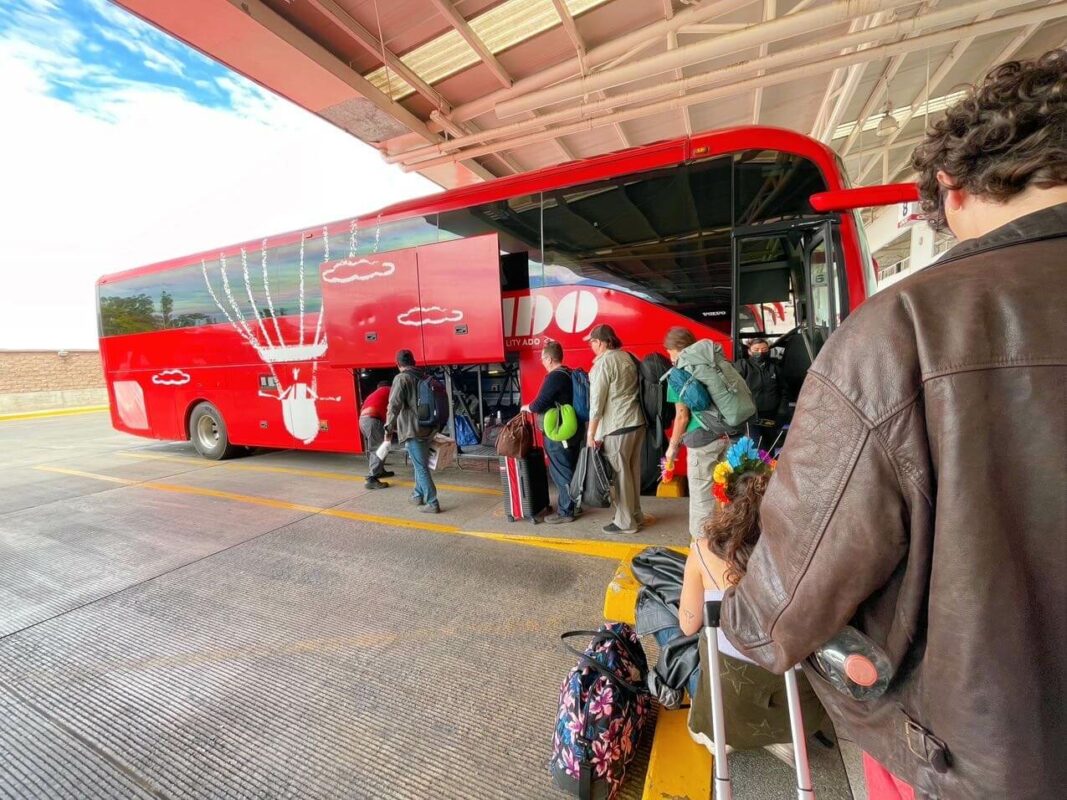
By air: Oaxaca has a small airport 12km from the city. Given its popularity, there are regular flights from all over Mexico. To get from Oaxaca airport to the city, you can take a private or shared taxi or a public bus. I use Skyscanner to find the cheapest flights.
By bus from Mexico City: the main operator in Mexico is ADO (which is super comfy and convenient) which arrives and departs from the Primera Clase station near Jalatlaco neighborhood. It’s a decent bus station with good facilities. There’s another bus station where cheaper services like AU buses arrive and depart, however this station isn’t so nice.
By bus from the Oaxacan coast: to arrive and depart the Oaxaca coast, bus is an option. To Huatulco, take a bus to ADO Bahias de Huatulco station. To Mazunte, it’s a 7-hour bus through the mountains (beware this is very sickness-inducing!). Alternatively, take an ADO or OCC bus to Pochutla then a colectivo or taxi the final stretch to Mazunte.
How to get around Oaxaca City, Mexico
On foot: it’s easy to explore by simply walking around, and the benefit of this is soaking up the sights and hidden gems as you go. For attractions further afield…
By taxi (private or shared): it’s easy to hail cabs whether you’re going to Monte Alban or places in the other direction like Teotitlan del Valle. Private taxis operate as you’d expect them to while shared taxis require a little knowledge. Look for the destination on the front and, if it’s where you want to go, hold up the same number of seats as fingers you need.
Note – there’s no Uber in Oaxaca but there is DiDi through the DiDi app. However, often there are no drivers available.
Bus: local buses are an inexpensive mode of transport, connecting the city with other villages. Usually, you sit down and wait for someone to come around collecting fares.
Things to do in Oaxaca City in 2024
Let’s get stuck into it! I’ll start with the city center and cover the day trips after.
Explore the Zocalo
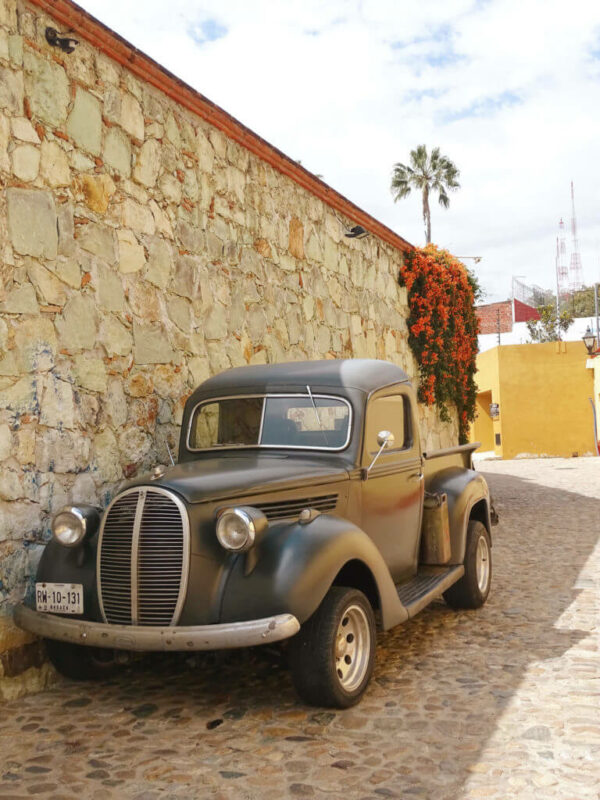
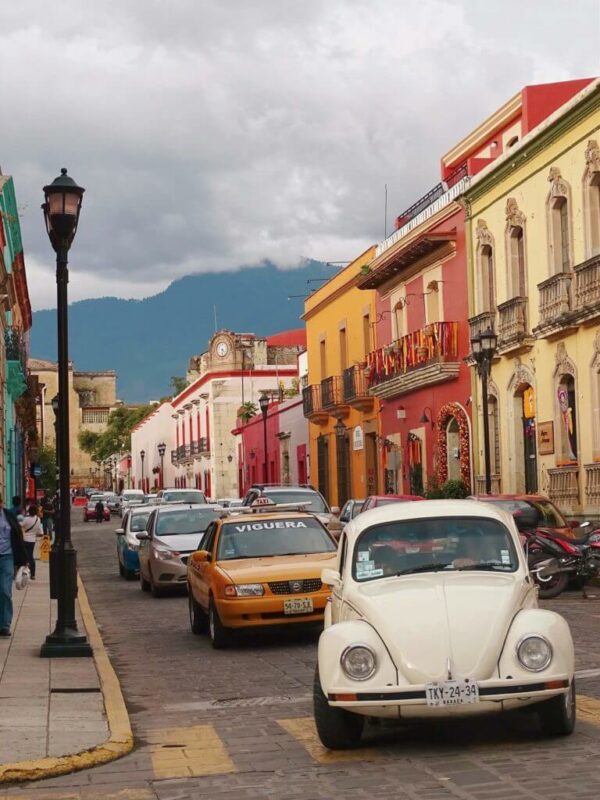
The Zolaco (city center) is one of the most charming parts of Oaxaca (and also the busiest; I’ll share some more idyllic and quiet neighborhoods later).
The main walking street through the city is Macedonio Alcalá Street connecting Oaxacan attractions such as the Church of Santo Domingo de Guzmán. It’s lined with galleries and stores where you can shop or simply window shop. As the street passes the church, there are stands where you can try traditional street food.
It begins near Barrio Xochimilco, one of my favorite neighborhoods which I’ll mention later.
Templo de Santo Domingo de Guzmán
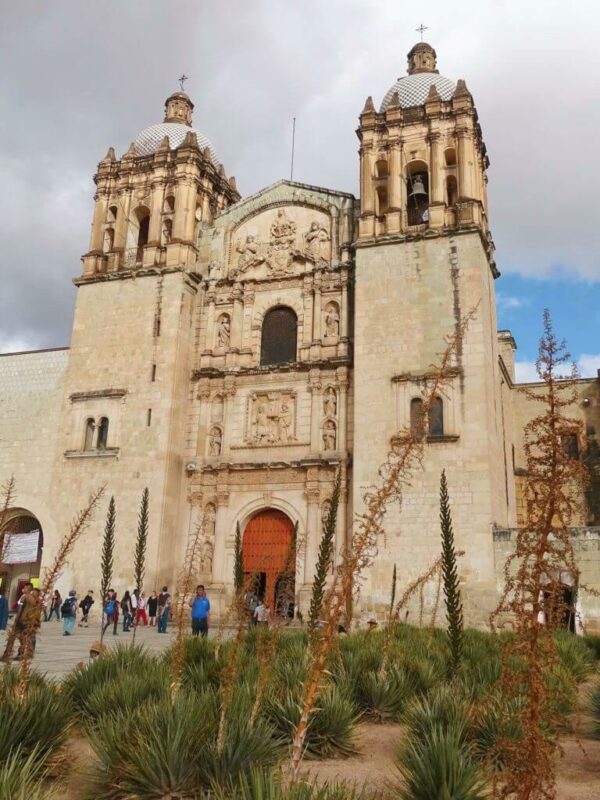
At the heart of the city, this is one of the places you can’t miss; partly just because it’s so vast! Templo de Santo Domingo de Guzmán was built between 1570 and 1608 in New Spanish Baroque style and remains to this day one of the most striking buildings in town.
The building was designed by Spanish architect, Fray Francisco de la Maza, and artisans from the city of Puebla were recruited to help with the construction. If you’ve been to Puebla (spoiler, you should!), you’ll understand why: they have nearly as many churches as days of the year, so they surely knew what they were doing!
A prehispanic temple dedicated to Zapotec ruler, Cosijoeza, was destroyed so this church could be built on its original spot. Sadly and ironically, he was a warrior who fought to protect his land from enemies.
You can go inside the church for free but I recommend you spend 90 pesos on visiting…
The Museum of Cultures (my favorite thing to do in Oaxaca!)
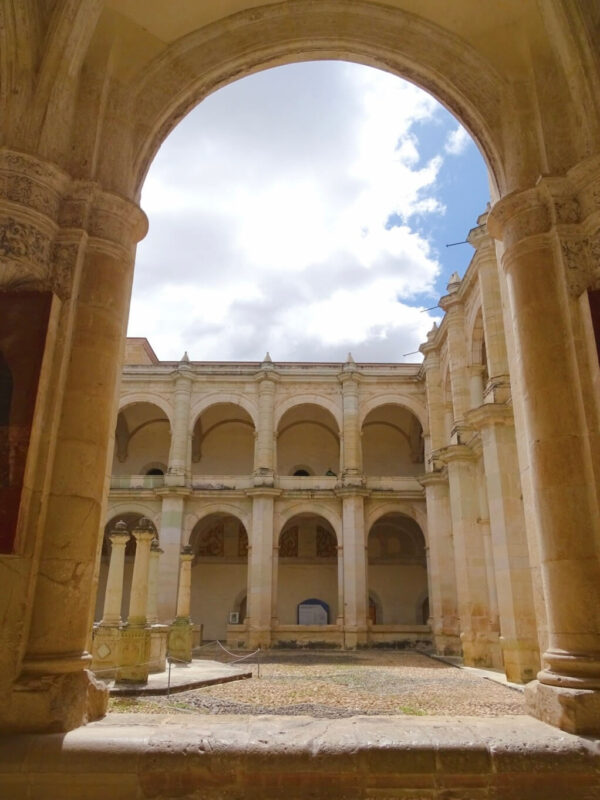
The Museum of Cultures of Oaxaca is a fascinating place to visit in Oaxaca with a wealth of exhibits and information, set inside an old 16th-century monastery. It’s worth a visit just for the building alone!
There are 14 halls to explore and you could easily spend several hours here, especially if you’re interested in pre-hispanic history. Despite the very Spanish look of the monastery, it’s now a celebration of cultures including the Olmecs, Zapotecs, and Mixtecs.
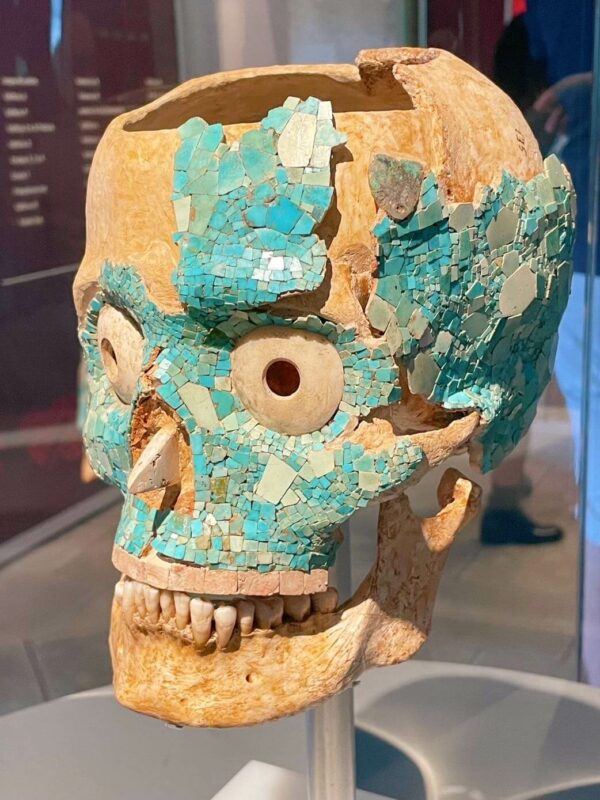
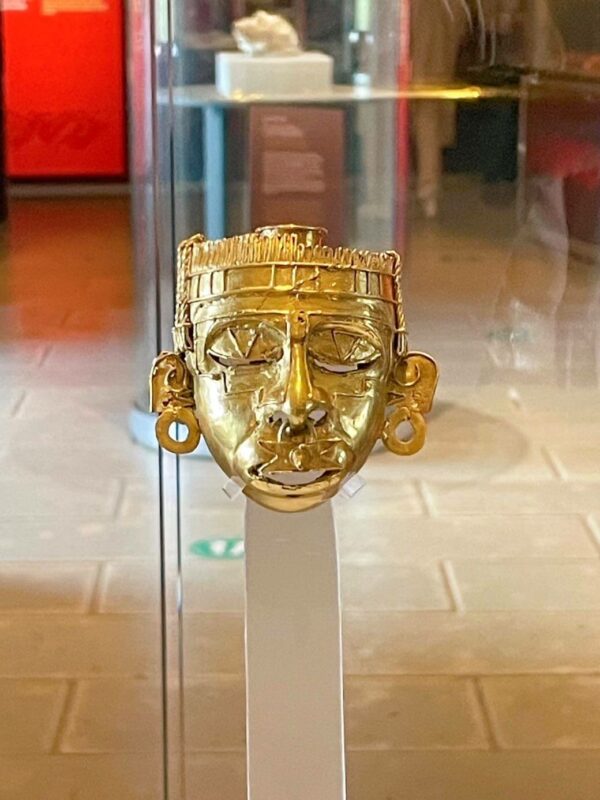
From turquoise skulls to masks, clay statues, exquisite jewelry, and cups made of rock crystal, these sacred items have stood the test of time thanks to diverse materials like obsidian, amber, bone, and clay.
Many of the items come from the excavation of Tomb 7 of Monte Alban (an archeological site nearby I’d highly recommend visiting) while other items come from other areas of Mexico, yet they all represent cultural practices from this area.
Most of the signage is in English as well as Spanish.
There’s also a stunning Spanish library downstairs at the Museum of the Cultures of Oaxaca full of ancient books and manuscripts.
Entry fee: 90 pesos.
Opening times: 10am-5.30pm, Tuesday-Saturday (last entry 5pm); 10am-3.30pm, Sunday (last entry 2.30pm). Closed Mondays. Note – the times on Google don’t seem to be correct; these times listed are the official ones I noted down at the Museum itself.
Botanical Gardens
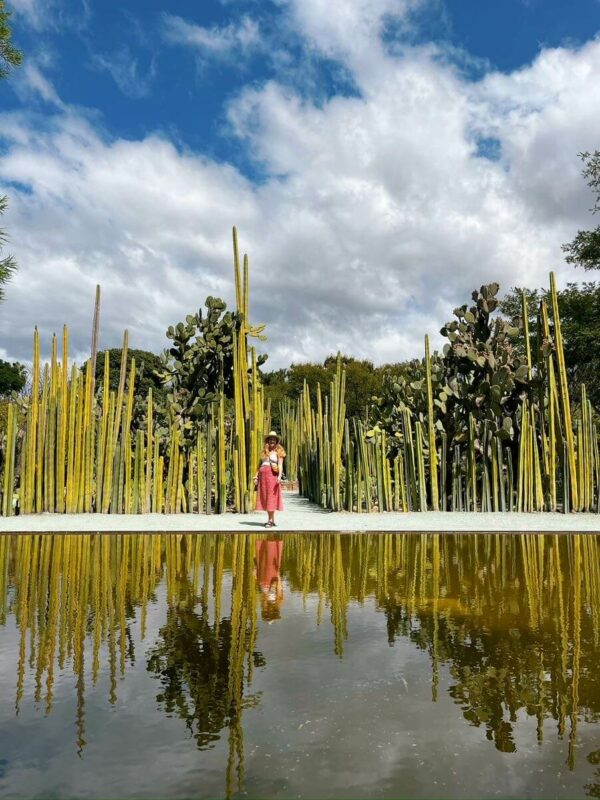
Easily one of the best things to do in Oaxaca City is visit the Botanical Gardens, once belonging to the church and monastery (you can see them from the windows of the Cultures Museum).
The Jardín Etnobotánico de Oaxaca (Ethnobotanical Garden) is filled with rich flora and fauna including towering cacti, designed to explore the relationship between plants and people.
A fun fact is that the government wanted to make the gardens a luxury hotel and car park but luckily it was saved from this depressing fate!
Getting tickets: For such a popular tourist attraction, it’s surprisingly fiddly to organize because you can only visit as part of a guided tour and these sell out fast. My friends and I arrived almost an hour before the 11am English tour (but granted this was around Day of the Dead so it won’t be as busy at other times) and it was already sold out.
So we ended up taking the Spanish tour (these are more frequent throughout the day) which was 1 hour and just 50 pesos, while the English tour is 100 pesos and 2 hours. So, if you speak basic Spanish, it’s probably best to hop on this tour unless you’re keen on a real deep dive into all things botanic during the longer English tour.
English tours are at 11am on Mon-Sat and Spanish tours are at 10am, 11am, 12pm, and 5pm, Mon-Fri and 10am, 11am, and 12pm on Sat.
Cathedral and Zocaclo

Right beside the main Zocalo Square is Catedral de Nuestra Señora de la Asunción (Cathedral of Our Lady of the Assumption). Construction of the Metropolitan Cathedral took from the 15th to 18th centuries, halted by earthquakes, but it was worth the wait.
Those who have been to the Historic Center of Mexico City or Puebla may notice it looks similar to their metropolitan cathedrals as they were all built in the same style.
Don’t miss the third main religious building in town, La Basílica de Nuestra Señora de la Soledad beside Plaza de la Danza (the political heart of the city where events and celebrations take place). The church is a favorite with the locals because it’s dedicated to the patron Saint of Oaxaca and, therefore a great place to see local life.
Snap the backstreets and classic cars
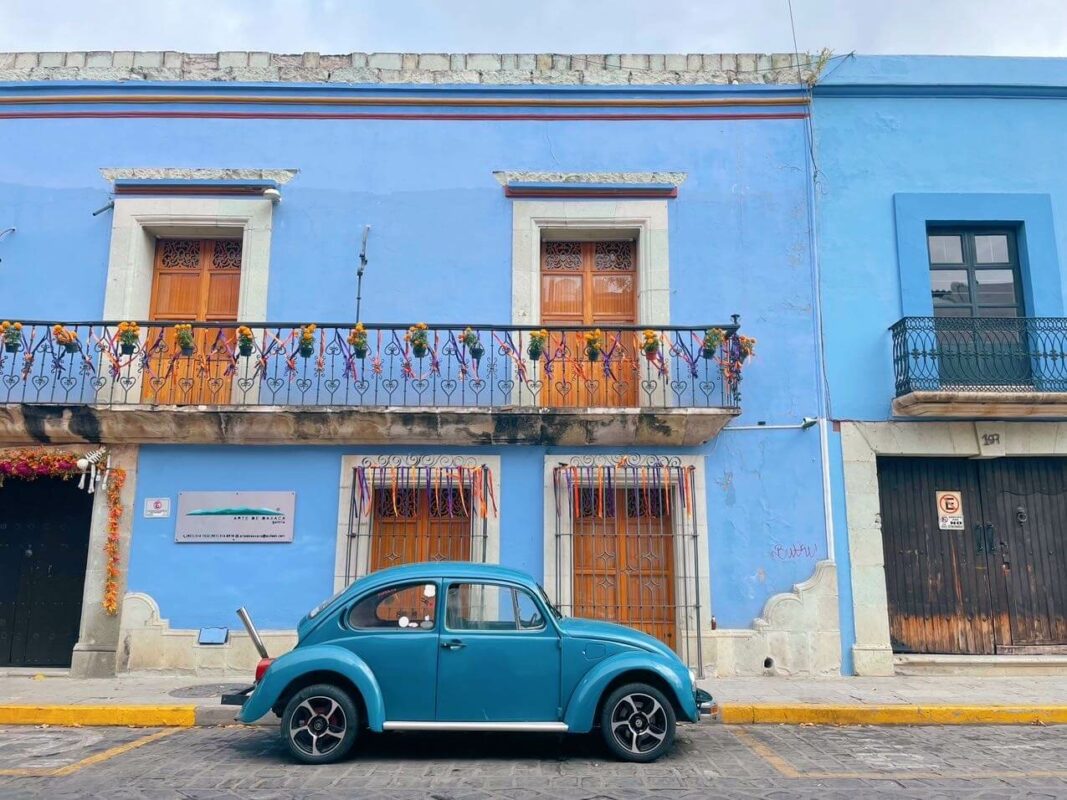
The busy streets of the Zocalo, particularly Calle Macedonio Alcalá, are full of attractions but I prefer exploring the backstreets of this safe, colorful city.
This is where you’ll see unique architecture and retro Volkswagens (from the plant in Puebla open since 1965) alongside cool cafes serving third-wave coffee and stands dolling out authentic street food.
Take a free walking tour
I do these everywhere! This informative tour easily constitutes one of the best things to do in Oaxaca. English tours take place from Mon-Sat at 10am, 1pm, 4pm, and 5pm and on Sundays at 10am and 4pm.
Spot a guide with a yellow umbrella at Teatro Macedonio Alcala to find the starting spot. Reserve your spot on the website or WhatsApp. Although the tour is free, you can give a tip that feels appropriate. I usually go with around 100-200 pesos ($6-12).
Climb to Guelagetza Stadium for amazing views
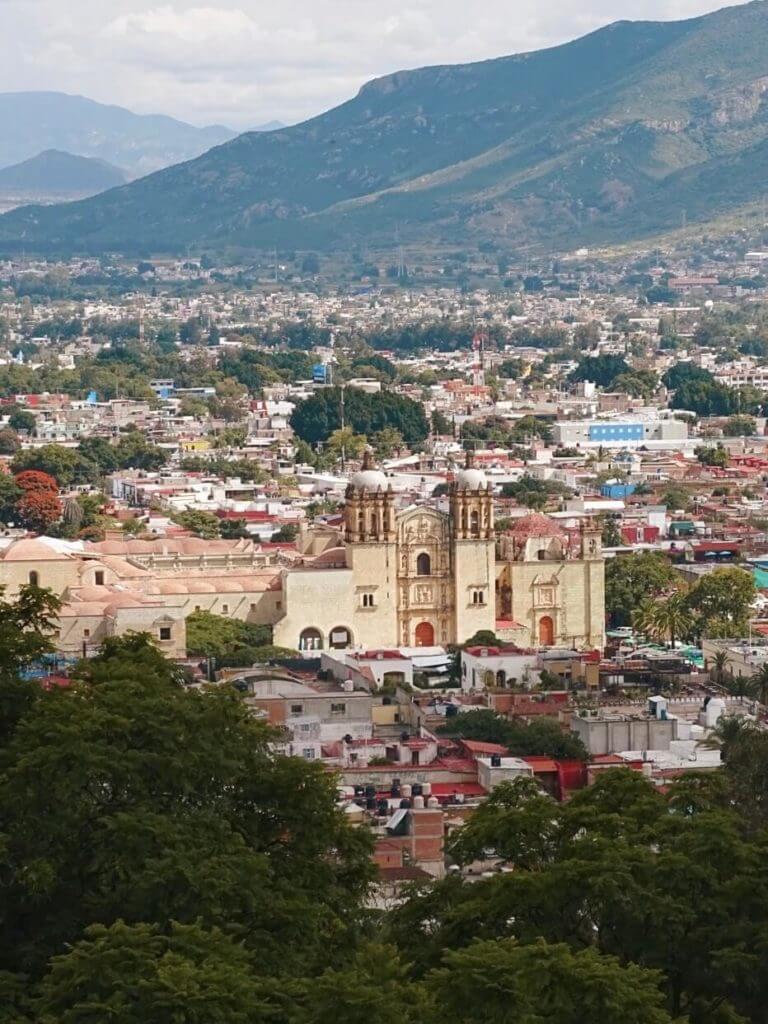
The stadium used for July’s Guelaguetza festival (more on this to come) is located high on the hillside and offers spectacular views of the city. It’s a strenuous but short climb that’s well worth it… And an excuse to eat more delish Oaxaca food when you get back down!
20 de Noviembre Market
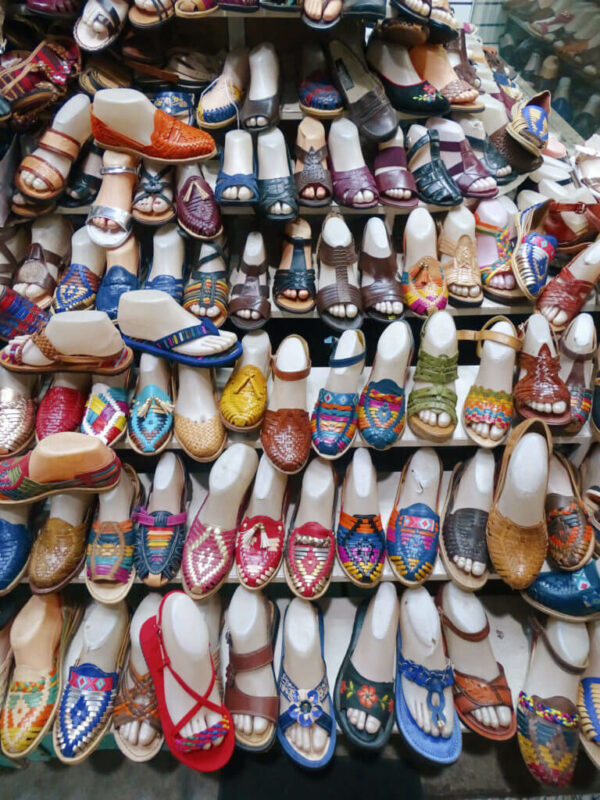
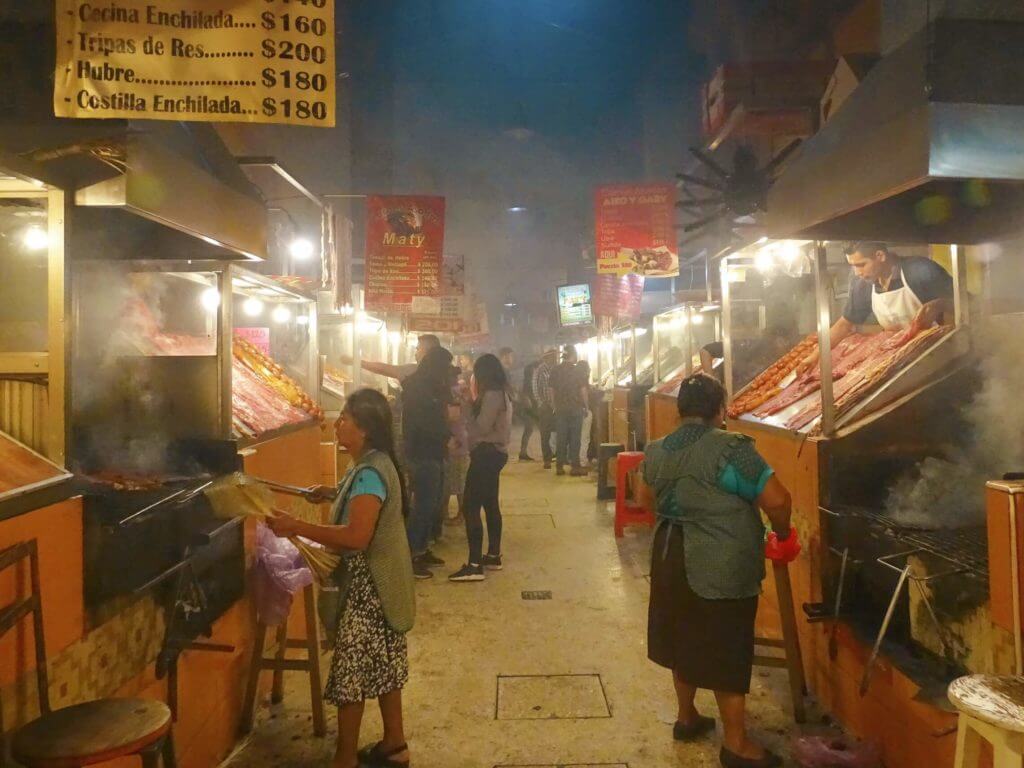
The lively markets are some of the top tourist attractions of Oaxaca; one of my favorites is Mercado 20 de Noviembre, a hectic blend of colorful souvenirs and tasty food.
For meat eaters (vegans stay away I beg of you!), don’t miss the famous meat alley. The specialty dish is tasajo (thinly sliced beef) grilled over hot coals. It’s made to order so you can tell the vendors how much you want. A little Spanish will go a long way!
If you’d prefer something different, there’s plenty to try at the market. There are several alleys of food where vendors are keen to show you their menus listing enchiladas drowned in mole sauce and crispy tlayudas (often called Oaxacan pizzas) topped with quesillo cheese and other meaty and veggie ingredients.
If you’re feeling adventurous, be sure to try chapulines. These crispy fried grasshoppers may look offputting but they’re surprisingly tasty, a bit like popcorn!
Explore more Oaxaca markets
Don’t stop with one! This is market heaven with plenty of artisan crafts and food markets to peruse. Since eating and shopping are two of the best things to do in Oaxaca (and everywhere?), don’t miss…
Mercado Benito Juarez
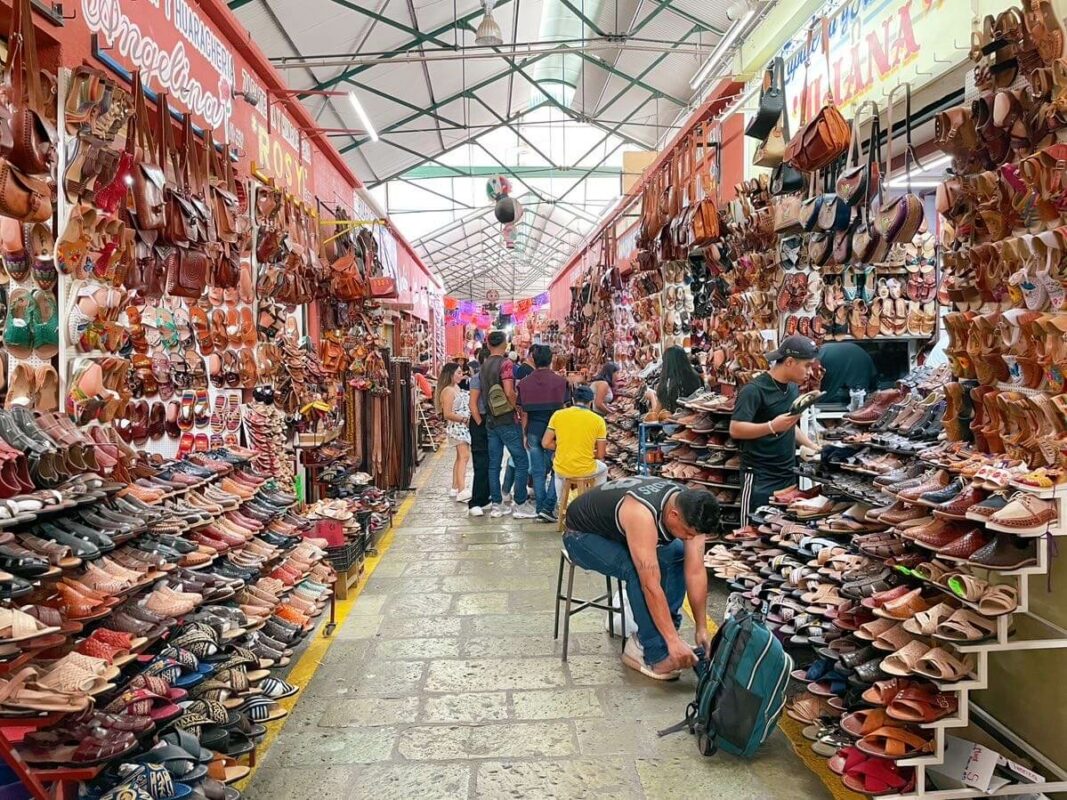
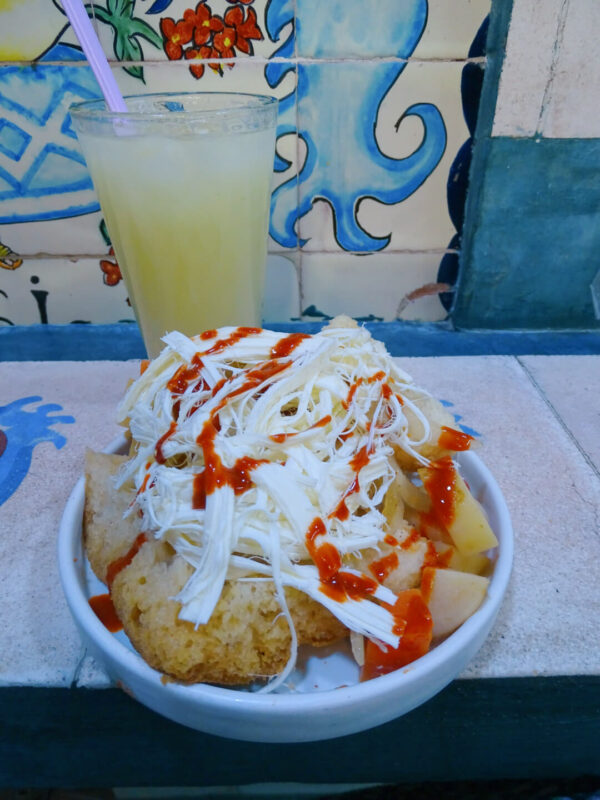
Mercado Benito Juárez is another of the most popular markets selling food, crafts, and textiles. The impressive alley entirely of leather shoes is a site to behold. Although there are far fewer food options here than in nearby Mercado 20 de Noviembre, there’s one famous counter that’s been open for 50 years: El Posito.
They sell a typical Oaxacan dish called piedrazos. Crunchy biscotti-style bread is soaked in vinegar and topped with cheese and hot sauce, alongside pickled potatoes. It wasn’t my favorite dish but it’s a unique delicacy to try (and cheap). When in Oaxaca!
Wash your food down with a sweet horchata or agua fresca.
Oaxaca Artisan Market
As the name suggests, Oaxaca Artisan Market sells all kinds of craft items from clothing to cushions, rugs, jewelry, and other trinkets. Your Spanish skills will be put to good use here as you haggle over beautiful items. It’s cash-only.
Note – there are bathrooms in or near most of the markets, costing 5 pesos to enter.
La Cosecha Organic Market
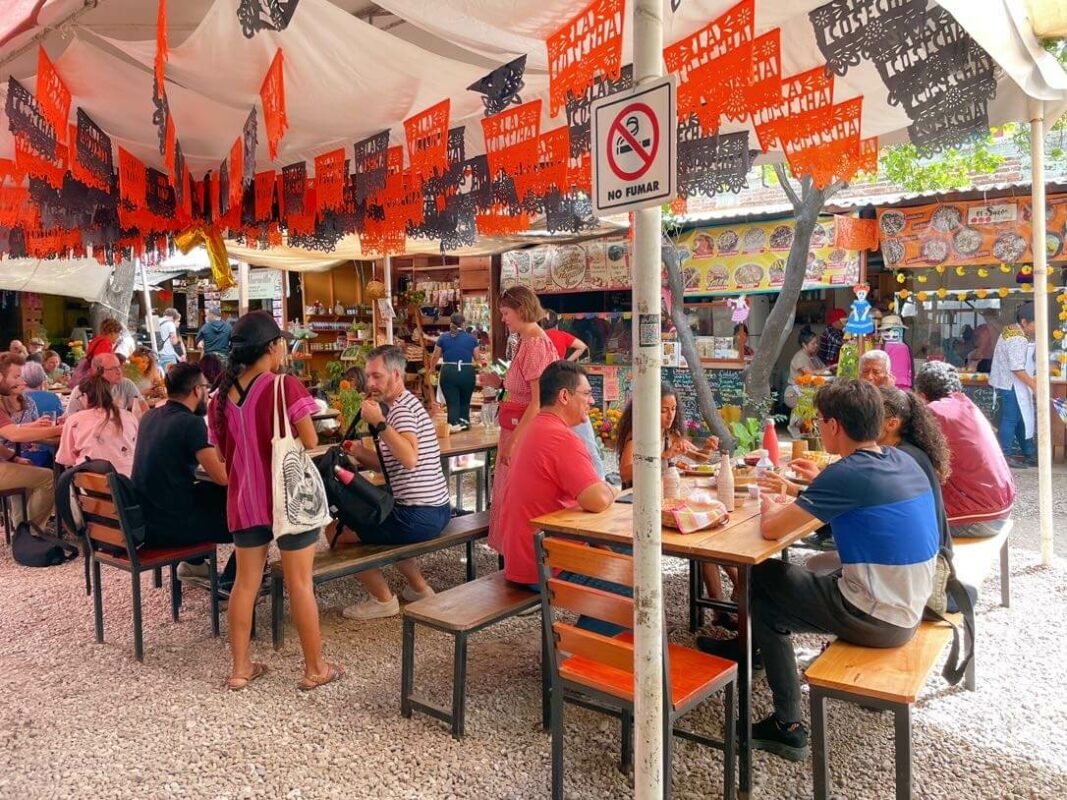
This outdoor market is far less hectic than the indoor markets mentioned above with far fewer smoky, meaty alleyways! It’s a beautiful venue with artisan shops at the front and a courtyard surrounded by trees and flowers.
There’s plenty of food for vegetarians, plus organic drinks like aguamiel (sourced straight from the agave plant) and ice cream, plus natural supplements and beauty products for purchase.
Catch a loco Lucha Libre match
This famous, loco wrestling is best seen in Mexico City’s Arena de Mexico, but if you’re not visiting the capital, you can tick it off your bucket list here.
Although wrestling exists around the world, there’s nothing quite like lucha libre! From the crazy costumes to the over-the-top acting, it’s more like an entertaining show than anything else… And a fun thing to do in Oaxaca City at night even if you have NO interest in wrestling (like me).
There are two stadiums where you can see lucha libre in Oaxaca: Arena Pepe Cisneros and Arena San Francisco. Find a show by spotting posters in town or checking the Facebook page. Expect to pay around 250 pesos per ticket.
Explore Barrio de Jalatlaco
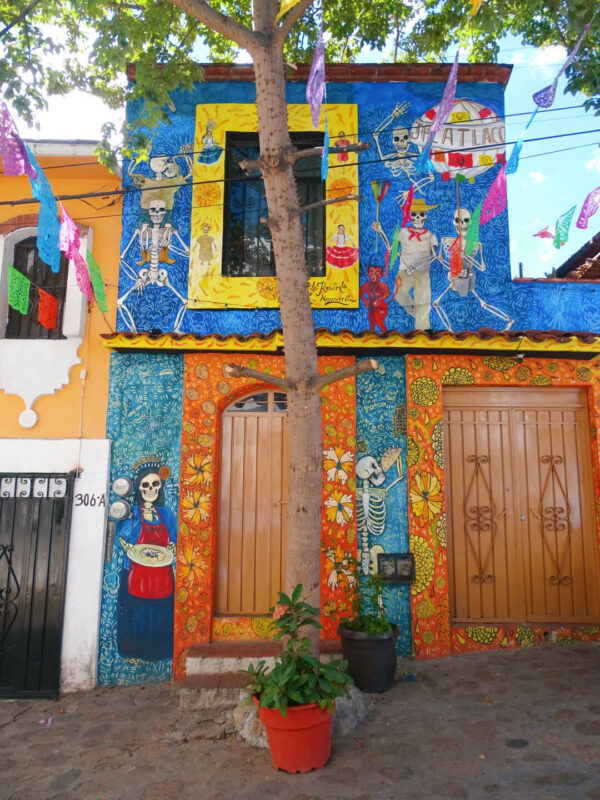
When it comes to sightseeing in Oaxaca City, I urge you to go beyond the city center. I love the pleasant neighborhoods you can reach on foot within 10 minutes. My favorite place to visit is Barrio de Jalatlaco, a blissfully colorful area splattered with street art.
There are some great coffee shops including a new branch of Boulenc (a popular restaurant in the center that has lines down the street at brunch time). They don’t do the full menu at this small branch but you can still try all the amazing baked goods with specialty coffee in an atmospheric setting.
The boutiques are also fantastic and some venues combine food and coffee, for example Once in Oaxaca where there’s coffee, sweet snacks, and artisan items to peruse.
If you’re not hungry or thirsty when you visit, simply wander the cobbled streets and spot colorful murals in the backstreets. It’s a wonderland!
Xochimilco neighborhood
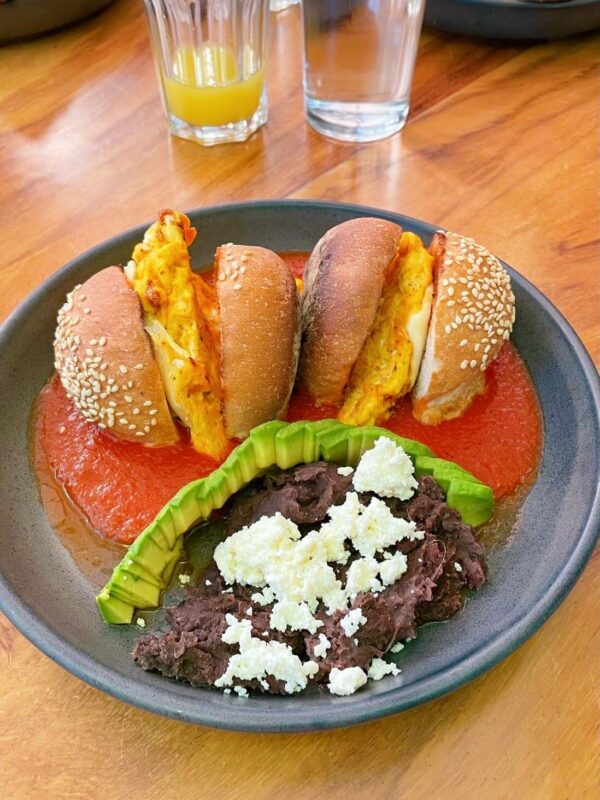
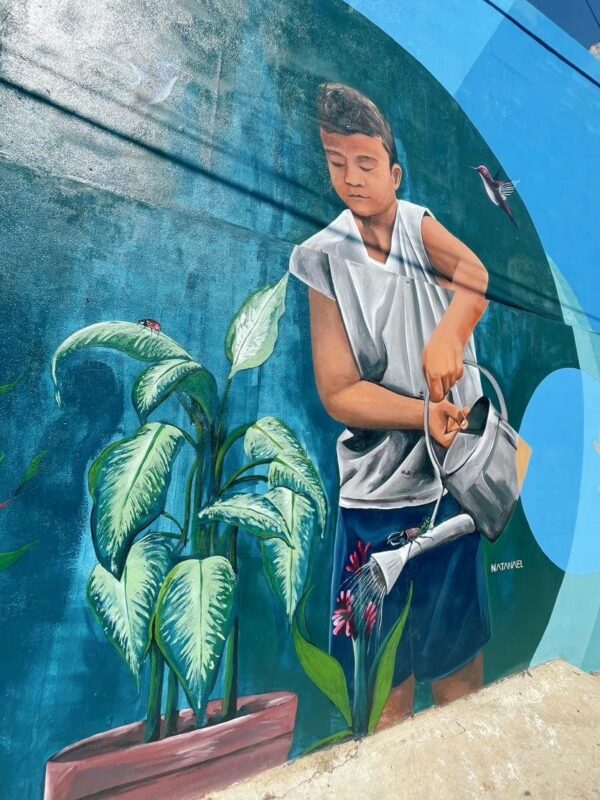
If you love colorful street art, don’t stop at Jalatlaco. The other peaceful suburb – and a great place to escape from the hustle and bustle of the center – is Xochimilco (not to be confused with the canal district of Mexico City).
Most of Oaxaca’s key attractions are not in this neighborhood but some of the best street art and cutest bakeries are. Chepiche Cafe is a favorite with delicious brunch dishes like the torta ahogada (‘drowned’ sandwiches originating from Guadalajara) while AM Siempre Cafe has great coffee and rooftop views from the terrace.
Arty things to do in Oaxaca
Oaxaca is such a creative and artistic city that you’re bound to feel inspired even if, like me, you’re not especially artistic yourself. I decided to dedicate a whole section to this topic
Browse small galleries and studios
Although there are some fantastic art museums (that I’ll mention next), one of my favorite activities in Oaxaca is simply wandering the small art stores, even if I don’t buy anything.
There’s a wide variety on offer from large, expensive pieces to tiny prints and stickers that are surprisingly affordable. You can get a small souvenir for as little as 30 pesos.
Voces de Copal is one of my favorite stores in the Zocalo, while Armadillo Graffico is a great option in the Jalatlaco neighborhood. The beautiful prints show Mexican animals like whales and hummingbirds, plus typical flora and fauna like mushrooms and cacti.
Print workshop
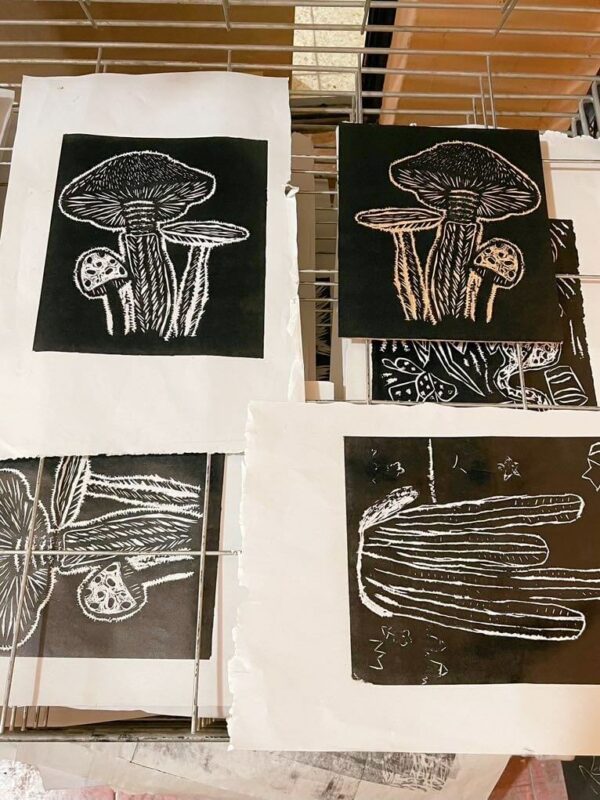
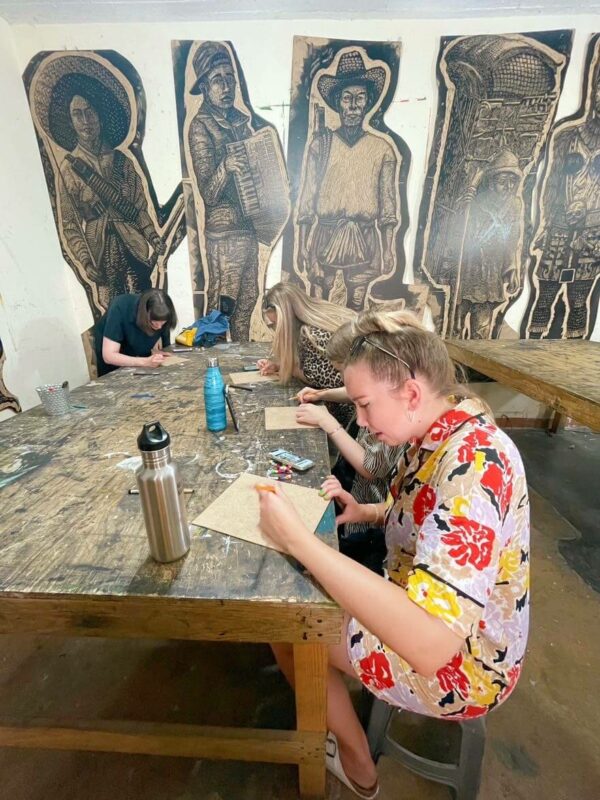
My friends and I had a blast doing this woodcut print workshop. This typical style of Oaxacan art is seen everywhere from galleries to street murals.
You create the illustrations ‘backward’ by drawing the design in black ink and then, using a scalpel, scraping away the lines. Then you use black ink and a press to complete the print.
The workshop with Colectivo Subterráneos takes 4 hours and costs 350 pesos for 1 person or 500 pesos for 2 people. It was great fun, even if I went with my sister and her artist friends whose creations made mine look terrible!
The studio is in Centro close to the Museum of Prehispanic Art. Classes take place at 10am, 1.30pm, and 3.30pm daily (the first is in Spanish only).
Textile Museum (Museo Textil de Oaxaca)
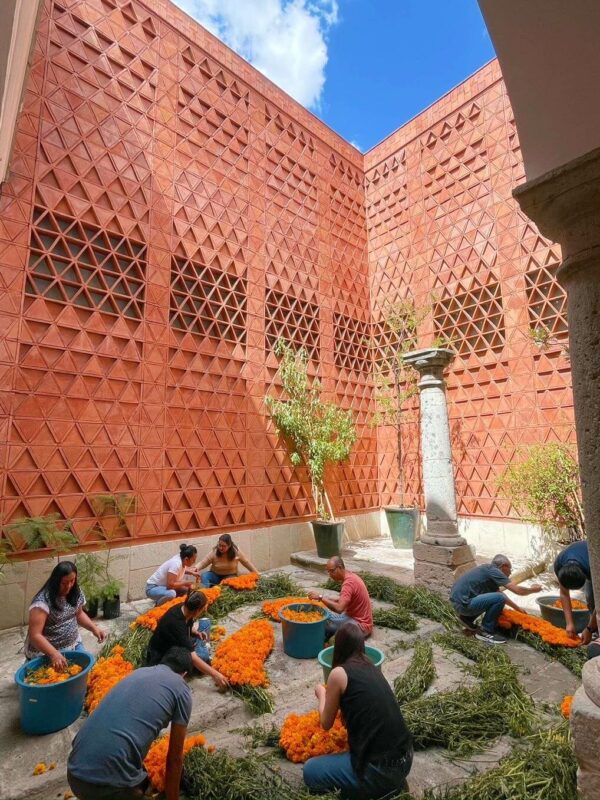
Oaxaca’s Textile Museum is a small but fascinating collection of indigenous items, predominantly clothing and other textiles. Not only are the items incredibly intricate and detailed, but the building itself is a work of art.
In late October, I was lucky to see members of the community preparing cempasuchil (marigold) flowers for the Dia de Muertos celebrations.
The information boards (including a couple in English) give context to the items. One board beside some women’s clothing describes the process of coming to adolescence in relation to dress and celebration.
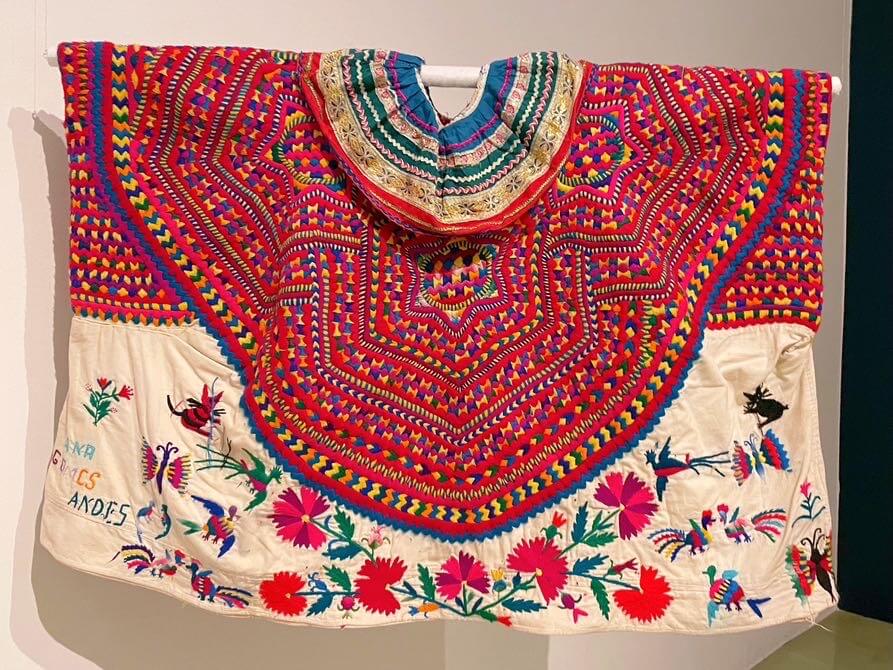
Entry is free (you just need to sign in with your name and nationality) and 30 minutes is enough time to look around.
Opening times: 10am-8pm daily.
Prehispanic Art Museum
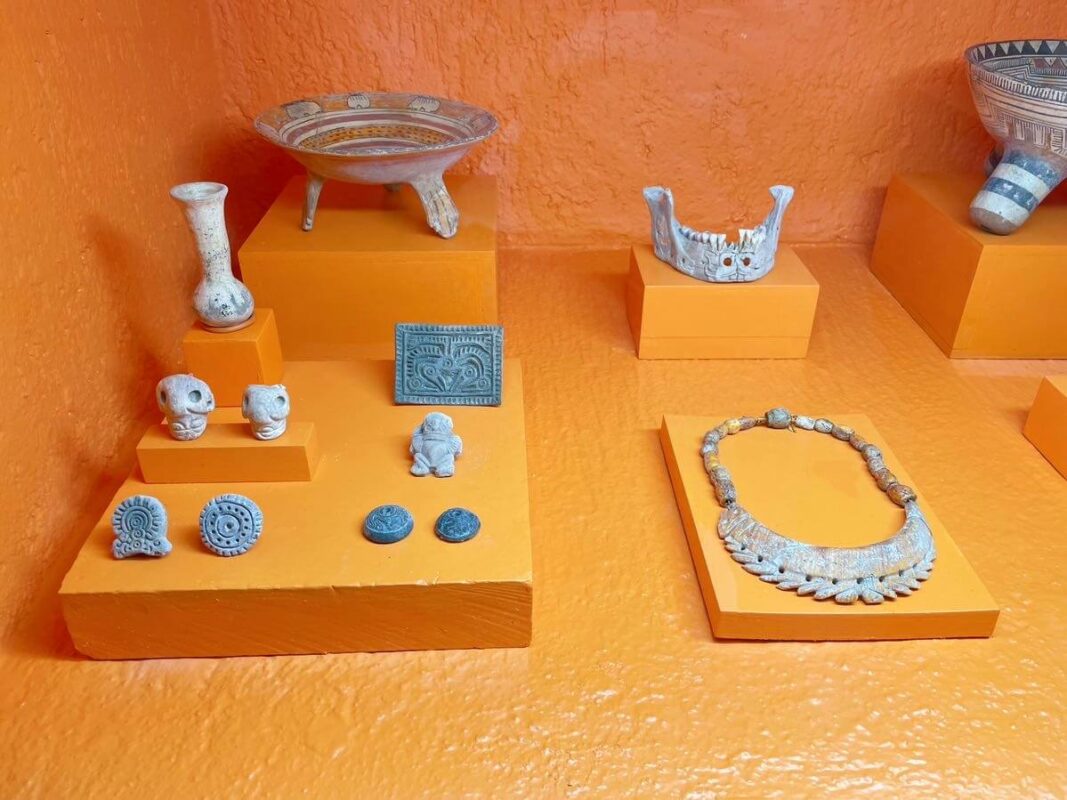
Unlike the modern galleries in town, all the items at the Museum of Prehispanic Art are at least 600 years old. Although you might initially describe them as artifacts rather than art, they’re all incredibly well-crafted from figurines to bowls and jewelry.
The items were collected and curated by Mexican artist, Rufino Tamayo, who also has a larger art museum in Mexico City. My favorite items were the Colima dog statues. Although these adorable clay canines can be found in tombs across Mesoamerica (they were considered crucial companions in the afterlife), they’re most commonly found in the state of Colima in western Mexico.
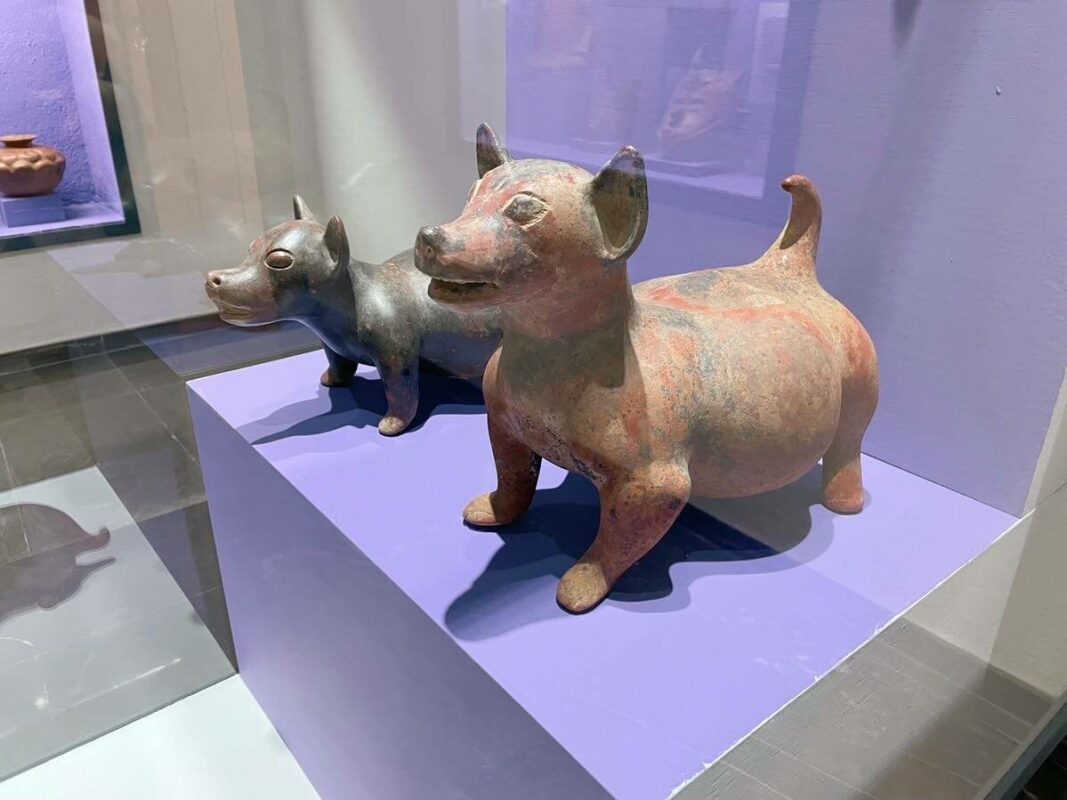
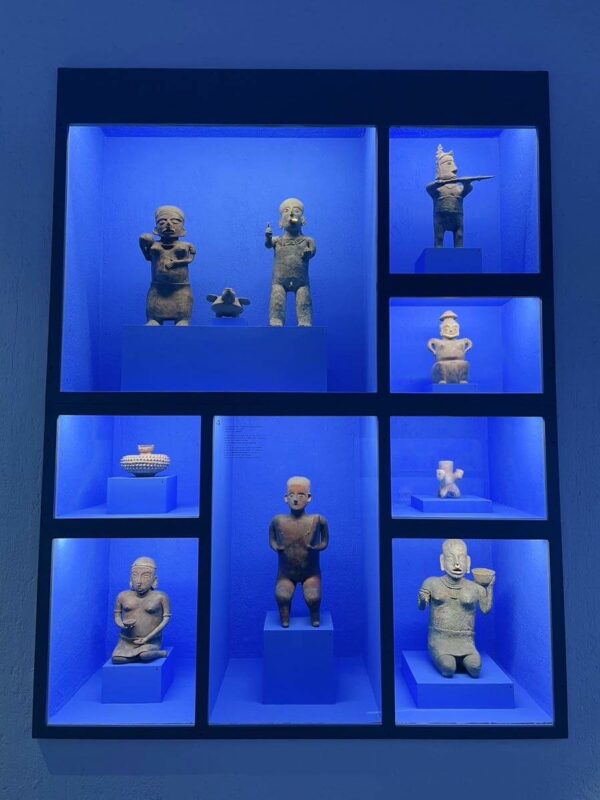
Around 1 hour max is needed to see the items on display. Like the other small galleries, entry is free.
Opening times: 10am-2pm and 4pm-7pm daily.
Museum of Oaxacan Painters
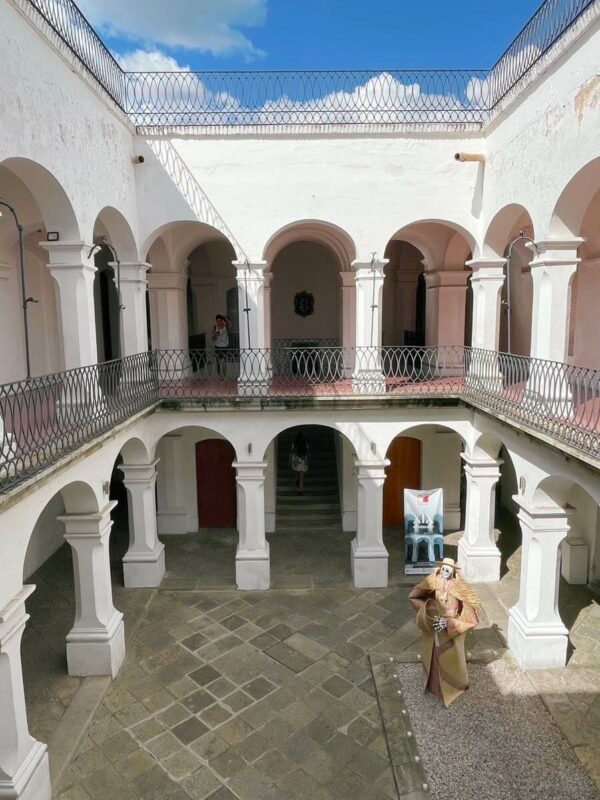
Another arty thing to do in Oaxaca is visit the Oaxacan Painters Museum close to the Zocalo. In a beautiful 17th-century building with a courtyard and two floors, it’s home to a variety of styles of art by artists such as Rodolfo Morales.
I loved the octopus painting by Soledad Velasco.
Entry is free but donations are welcomed. Opening times are 10am-6pm daily. Note – the bathrooms were pretty grim during my visit; I’d avoid!
More galleries
There are a LOT of galleries here. Told you Oaxaca was an arty place!
- IAGO (Institute of Graphic Arts) – another free art gallery with a library that doubles up as a good place to read or do some work. The house originally belonged to artist, Francisco Toledo
- MACO (Museum of Contemporary Art) – this museum is currently closed for renovation but the website (as of 2024) says it’s soon to reopen
- MUFI (Museo De La Filatelia) – I ran out of time to visit this lesser-known museum but some friends who visited sang its praises. It’s a beautiful building with a decent cafe and gift shop, but the highlight is the collection of artistic stamps (one showing Frida Kahlo) and every coin made since the year 1,500.
Visit art villages and paint your own alebrijes
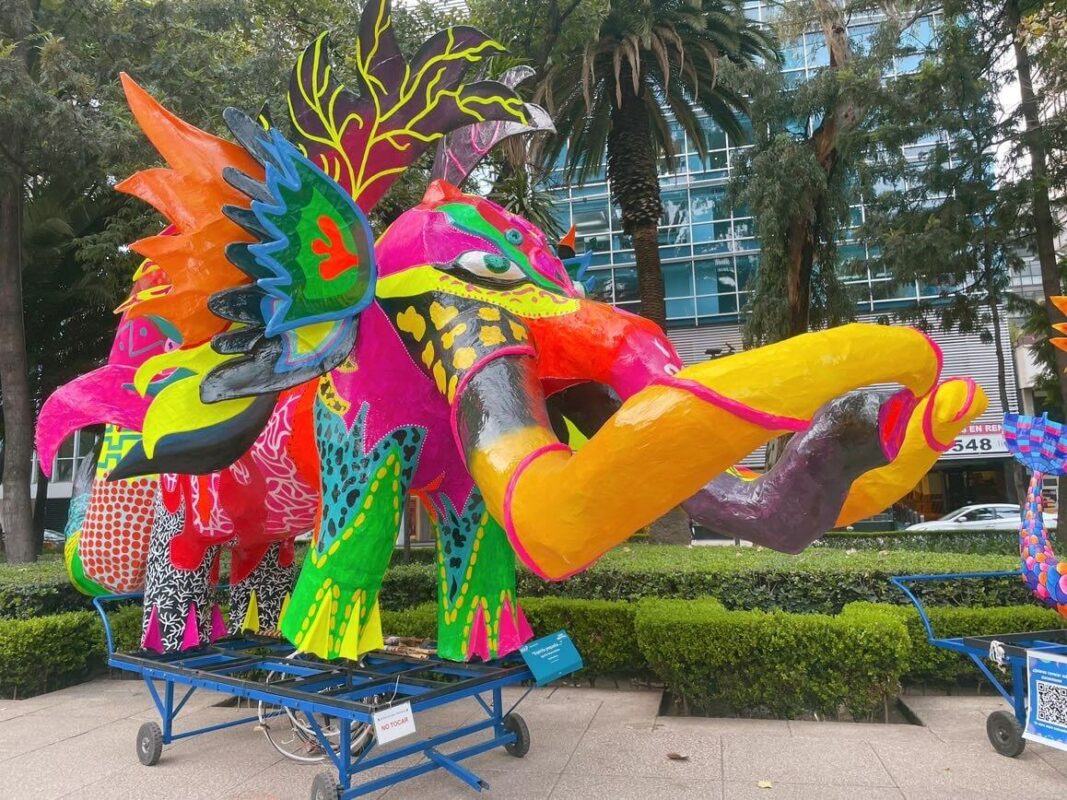
Ticked off the arty things to do in Oaxaca City? There’s plenty more in the villages.
The village of San Antonio Arrazola (to the west of the city) has large alebrije statues in the street as well as studios where you can paint a model to take home.
South of the city, you have the option to visit two close-together villages: San Martín Tilcajete, another alebrije town with plenty of studios where you can paint one, and San Bartolo Coyotepec known for black pottery. Santa Maria Aztompa (a village northwest of Oaxaca) is known for its striking green pottery.
Tour the street art
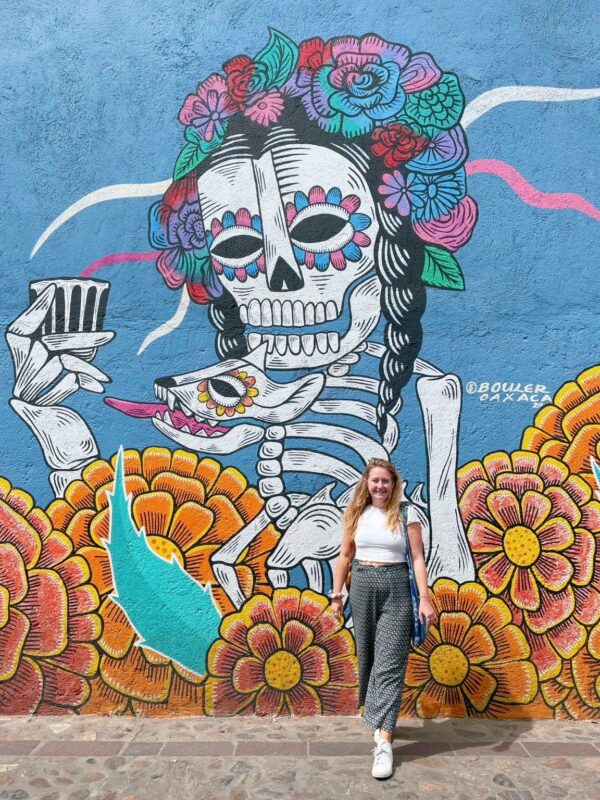
The street art in Oaxaca is some of the best in Mexico… Which is saying something because I’ve also seen fantastic murals in Holbox, San Cristobal, and countless other destinations.
You don’t see much in Zocalo but both Jalatlaco and Xochimilco neighborhoods are covered in murals. You can explore it solo and guess about the meanings or go with a local guide for an insight into the artists and the social and political themes behind the pieces.
What to do in Oaxaca for foodies
Oaxaca is (depending who you talk to!) the food capital of Mexico. Given the regional delicacies like tlyuadas, mole, and quesillo cheese, it’s certainly high up there as one of my favorite foodie destinations in Mexico – and there are plenty to choose from!
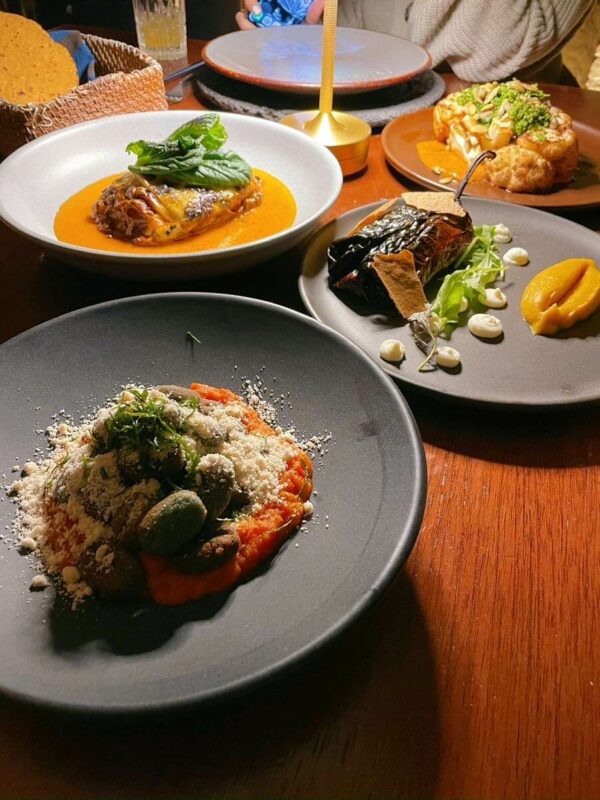
Here are the top activities in Oaxaca for foodies…
Mole tasting
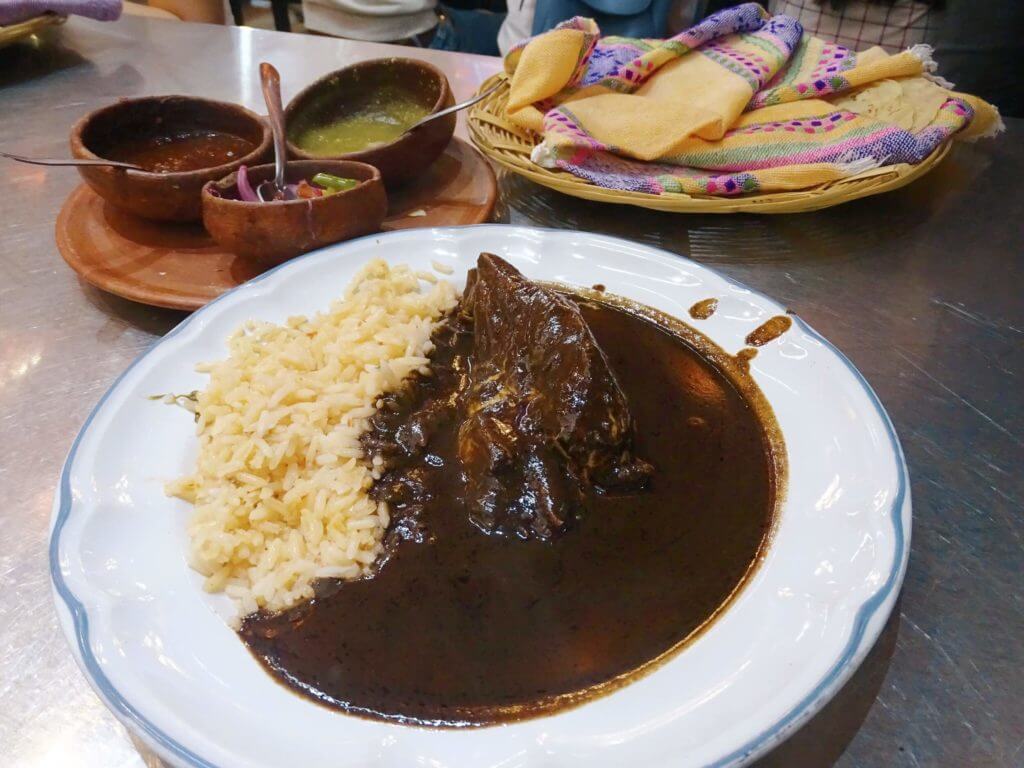
Already know and love mole? Not yet in the know about mole? Either way, you need to go mole tasting in Oaxaca!
There are famously 7 moles of Oaxaca but the most popular version is the black mole with dried chiles, garlic, seeds, garlic, raisins, chocolate, and much more. The addition of chocolate may seem strange until you consider that cacao has been consumed in Mexico for thousands of years and wasn’t sweet until Europeans took it home and mixed it with milk and sugar.
The other six are rojo/Poblano (red), verde (green), amarillito (yellow), coloradito (dark red), chichilo, and manchamanteles.
Restaurants all over the city serve mole so you won’t have trouble finding it. For a cheap and authentic portion, look no further than Mercado 20 de Noviembre.
Mezcal tasting
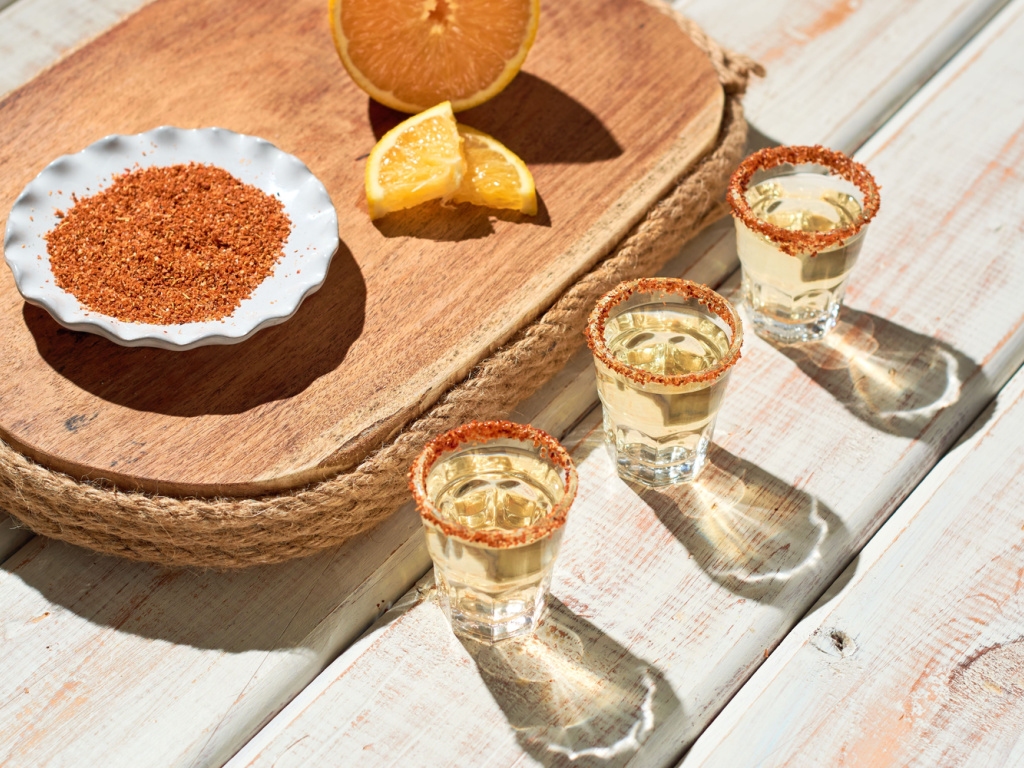
You can’t talk about mezcal without mentioning Oaxaca! This agave-based beverage has been drunk in the region for millennia, originating from the Nahuatl word mexcalli meaning cooked agave.
Mezcal is produced in abundance thanks to the fertile soil and warm climate of Oaxaca, but it’s the Spanish who can be thanked for the process of distillation. Before this, it would have been more like pulque.
Options for trying it include visiting a mezcal distillery (most in the countryside) where you can also learn about the production process or simply sipping it at any mezcal bar. Luckily, you’re never far from one! It’s best sipped with a side of sliced orange and worm salt.
A bar I like is Marsupial. As well as shots and flights of mezcal, they have a range of mezcal cocktails from 130 pesos. I liked the sour manzana one with apple, lime, and egg white. Another cool spot is Sobrio Speakeasy (although it doesn’t really have a speakeasy theme despite the name). To try a huge range, you can also visit La Casa del Mezcal with its old-school facade.
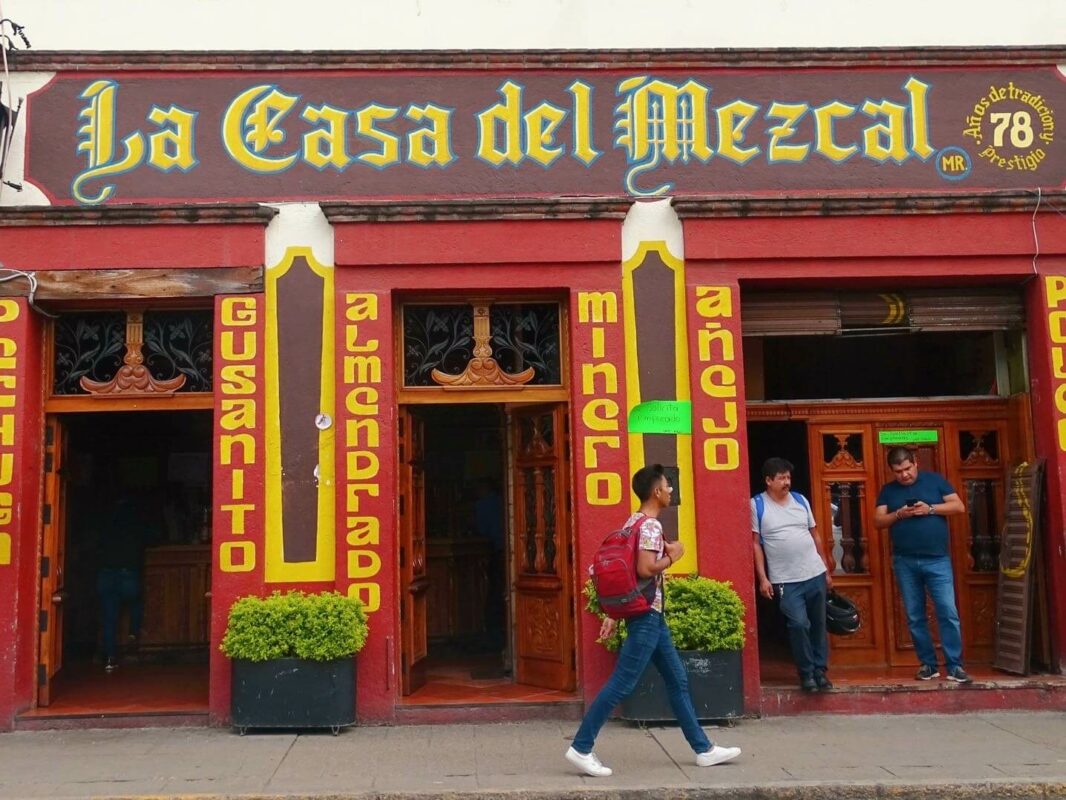
For a fun thing to do in Oaxaca City, try a mezcal and mole tasting tour
Sample Oaxacan chocolate
Once you’re familiar with mole and mezcal, it’s time to complete the trio of famous regional foods by trying Oaxacan chocolate! The cacao tree (Latin name Theobroma cacao) translates as ‘food of the Gods’. It’s no exaggeration!
Chocolate was originally not a food but a drink which is why I recommend trying drinking chocolate when in Oaxaca. Many cafes serve it made with either water (the Aztec/Mayan way) or milk (the modern way that many foreigners prefer).
If you’d rather buy solid chocolate to take home, head to any branch of Mayordomo. Big bean grinders give an insight into the production process while the shelves are lined with enticing chocolate goodies.
Tip – chocolate is pronounced in Spanish choc-oh-lah-tay. If you use the flat ‘e’ like we do in English, you may not be understood. It happened to me when I first arrived in Mexico!
Try tejate
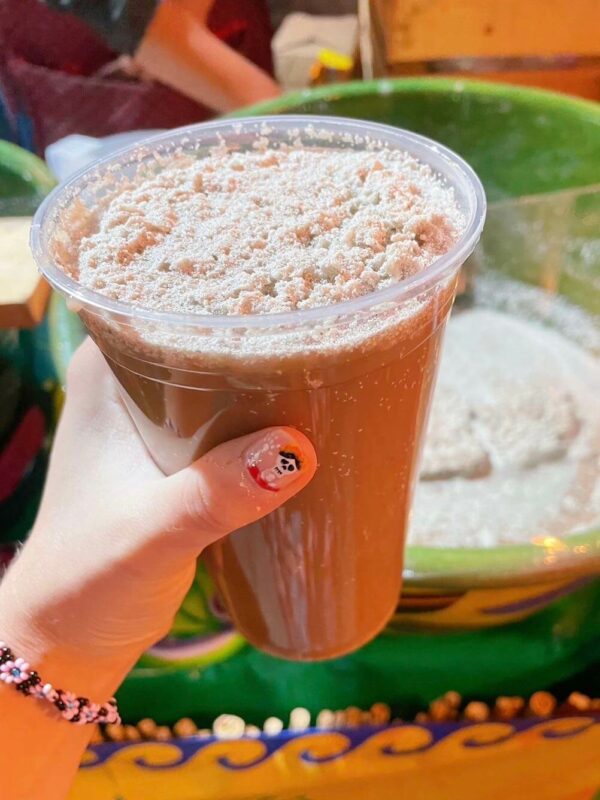
Once you’ve enjoyed a steaming cup of drinking chocolate, there are a couple of other typical Oaxacan drinks that no trip would be complete without. One is champurrado, made with milk, cornflour, sugar, and cinnamon.
But the most famous local drink is tejate (pronounced tea-hat-ay) made from maize and cacao. With centuries of indigenous history predating Spanish invasion, it’s a popular drink in Mixtec and Zapotec communities. Now it’s affordable enough to be drunk by all but it used to be reserved for royalty during religious ceremonies.
With the fuzzy layer on top, it looks strange but tastes sweet and delicious. Other ingredients include flor de cacao (a flower unrelated to cacao despite the name that creates the foamy top), mamey seeds, and roasted cacao beans. It’s a multi-step recipe that takes hours!
Tejate is said to be from the Oaxacan village of San Andres Huayapam where a festival is held each March. But you can find it everywhere, especially around Templo Santo Domingo where stands sell it for 20 pesos.
Tejate is served cold which was a shame in chilly November when I needed something to warm me up. At least there’s hot chocolate everywhere!
Visit the best restaurants
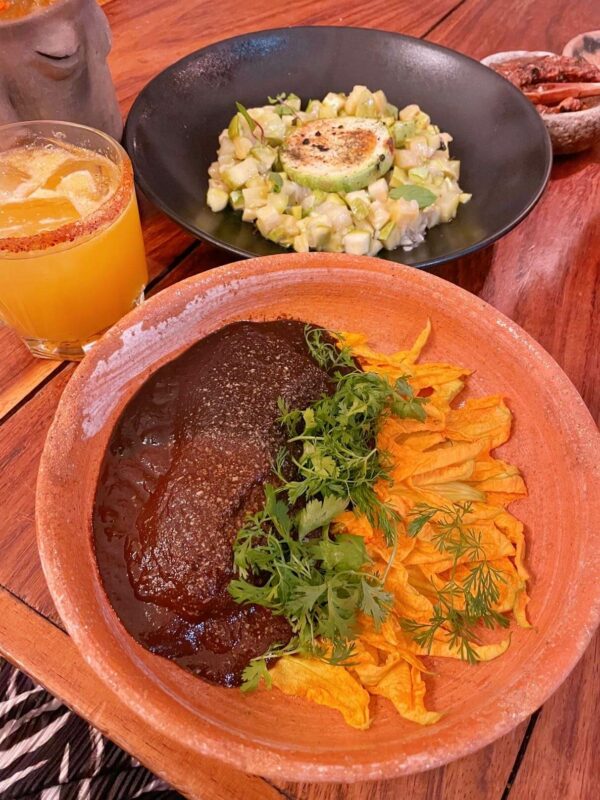
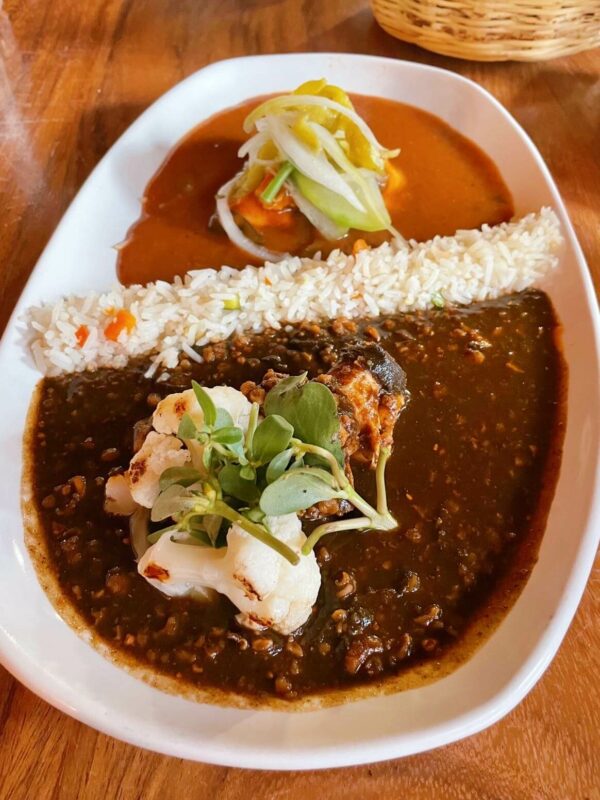
It may not sound like sightseeing but enjoying the culinary scene is easily one of the best things to do in Oaxaca. There are countless restaurants in this little city from high-end to casual street stands… and I’ve tried most of them! Some of my faves are:
Los Danzantes: this is a dream of a restaurant serving so many delish dishes like hoja santa leaves stuffed with goat cheese and salsa verde, Oaxacan mushroom lasagne, blue corn gnocchi with tomato and mezcal sauce, and giant chilis stuffed with huitlacoche (Mexican truffle). There’s lots for vegetarians alongside excellent mezcal cocktails.
Levadura de Olla: this is another authentic restaurant full of candles and local clay decor. The dishes are freshly made with organic ingredients. Our only complaint was some of the dishes were a little small – we needed a carb with the squash and cheese dish! The fruit and syrup buñuelo dessert was tasty.
Las Quince das Letras: everyone and their aunt recommended this place and it didn’t disappoint. Try typical moles such as black, red, and green. If you can’t choose, opt for the duo or trio of sweet or savory ones. Main dishes cost 200-300 pesos.
Make sure to have a drink after at one of the many terraces overlooking the city. We liked Cobarde, which is also a restaurant, with great views of Templo Santo Domingo.
Street food lady in Central de Abastas Market
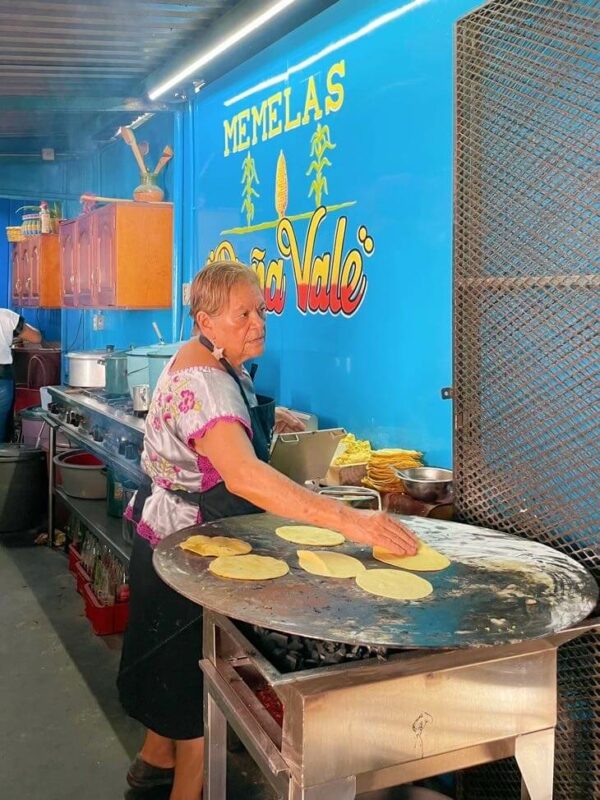
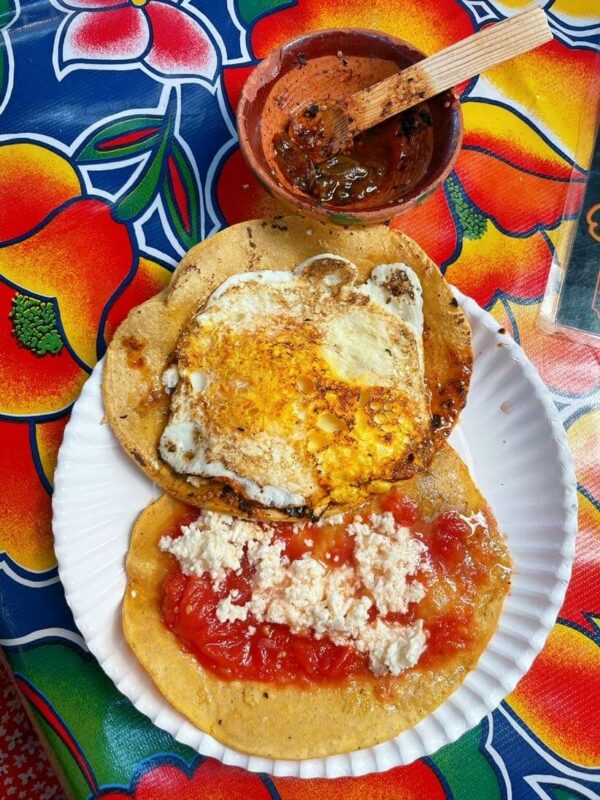
Some people advised me not to visit the gritty urban market of Central de Abastas Market due to its poor safety rating, however I had no problems. On sale are clothes, lingerie, accessories, flowers, meat, food, kids’ toys, homeware, and more… Overall, it’s an interesting and non-touristic place to visit in Oaxaca City.
There are better places to buy souvenirs, but there’s something that can’t be found elsewhere…
The memelas stand featured on the Netflix Street Food series run by the famous Doña Vale herself!
It may be touristy since it appeared on the show, but the food is still fantastic – and cheap! Memelas are corn patties topped with ingredients of your choosing. I kept it simple and veggie with fried eggs and the tomato and morita chili salsas. The latter was my favorite! Two memelas cost me 35 pesos.
How to find the stand: it’s pretty much where the Google pin says. If coming into the hall from the outdoor section, it’s down a small alley on your right. Ask someone ‘buscando Memelas Doña Vale’ and show them the photo above if you get stuck!
Have a drink at a top 50 bar
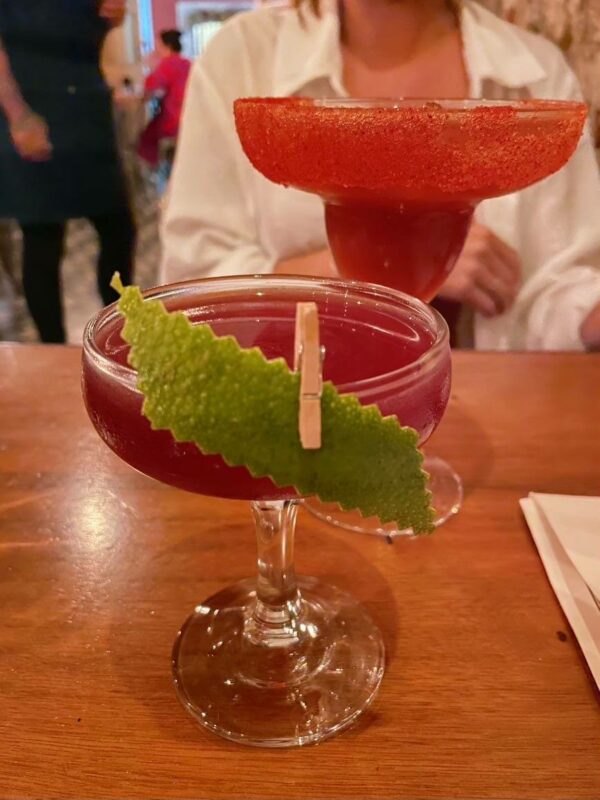
I love visiting places on the top 50 bars list (as my guide to Mexico City bars proves!) so I was happy to find one more in Oaxaca. Sabina Sabe is an atmospheric bar named after María Sabina, the famous female shaman known for her work with hallucinogenic mushrooms.
The food is highly related at Sabina Sabe but I’ve only tried the cocktails so far, all of which are creative house concoctions. I love the Jamaicon with mezcal, licor de chile ancho, jamaica (hibiscus), and lime juice. Most cost 190 pesos.
Take a cooking class
A memorable thing to do in Oaxaca for foodies is take a cooking class ($76). This typical cooking class includes a market visit where you’ll pick up seasonal ingredients for the dishes. Although the dishes change based on availability, there will certainly be mole!
Vegetarians can opt instead for this vegetarian cooking class ($69) where you’ll make a starter, main, and dessert according to traditional recipes. Yum!
Enjoy the coffee culture
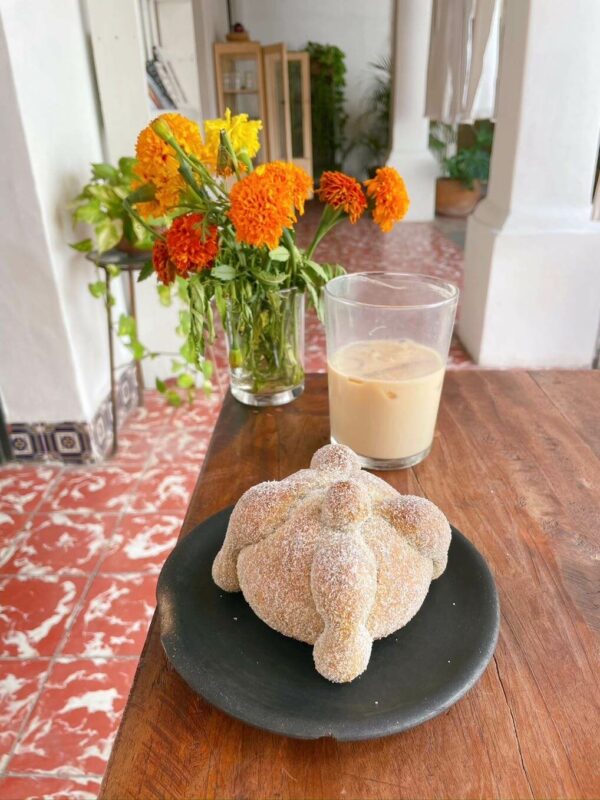
Coffee fans may see the countless coffee shops in Oaxaca as a reason alone to visit! Many of them serve famous Cafe Pluma from the Pluma de Hidalgo region of the state. I had the pleasure of visiting this place while ticking off the best things to do in Huatulco (the nearby region) but if you’re only visiting Oaxaca City, at least there are countless places to try it.
Some of my favorite coffee shops are:
- Marito&Moglie Café (Centro) – a cute space with a pretty courtyard and excellent coffee and baked goods. Don’t sleep on the iced latte.
- Muss Café (Centro) – this is one of the best places for specialty coffee and brunch in town. Better yet, you can order in the cafe downstairs then head up to the rooftop of Ama Terraza. It’s an aesthetic dream!
- Boulenc Pan y Café (Jalatlaco) – the second brand of this popular venue has a nice courtyard and unrivaled baked goods.
- Once in Oaxaca (Jalatlaco) – this cafe and art store serves delicious coffee with outdoor seating. Browse for souvenirs while you enjoy an iced latte and banana bread.
Try the best tacos in town at Tacos del Carmen
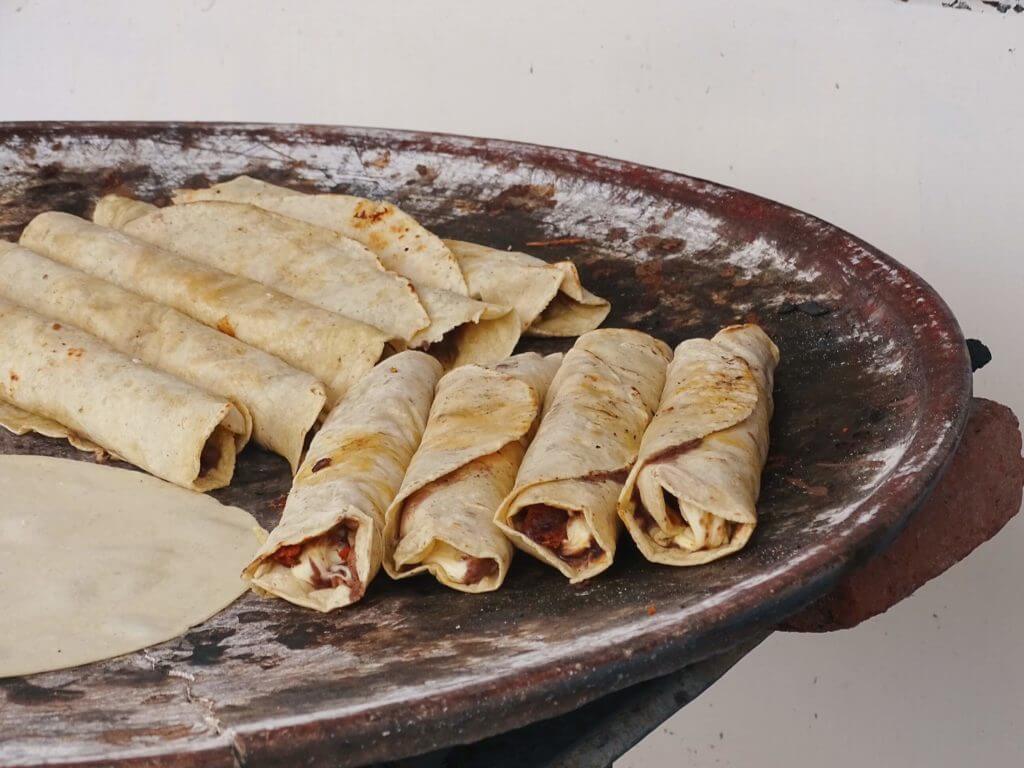
This was one of the first meals I ate in 2019 when I first visited (and fell in love) with Oaxaca. I’ve eaten there every time I’ve been back since!
Tacos del Carmen is a street food stand near the Zocalo serving homemade tortillas topped with local ingredients like frijoles (black bean paste), Oaxacan cheese, and flavorsome chorizo. Vegetarians can opt for delicious flor de calabaza (squash flower).
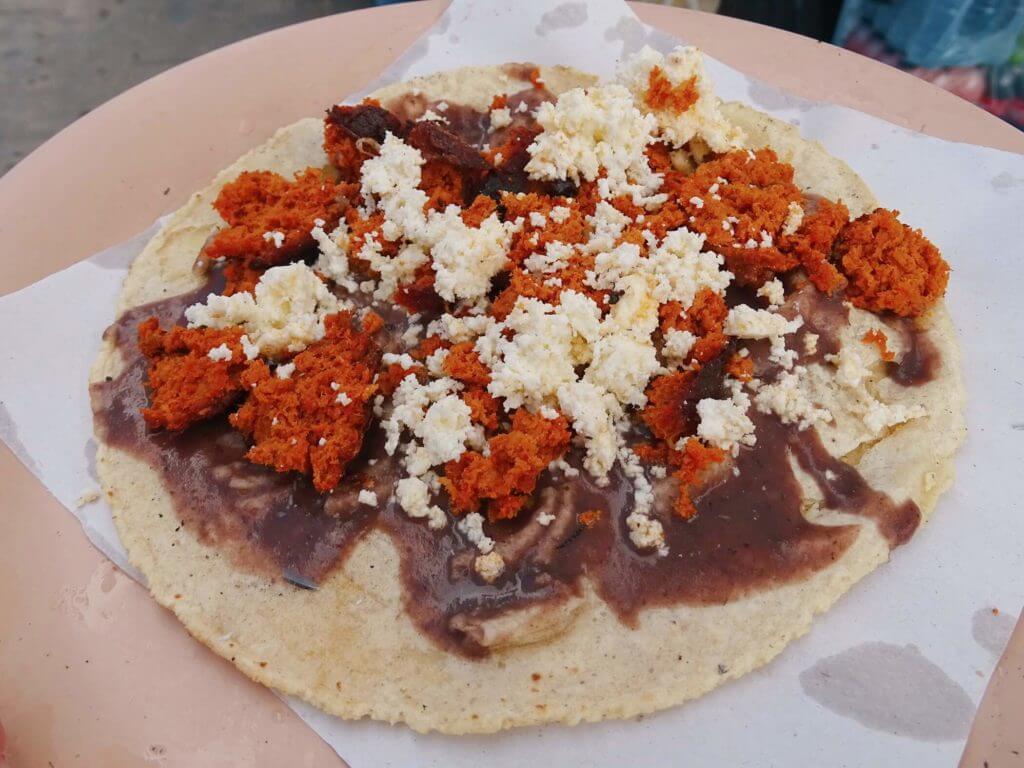
It’s often busy but don’t worry about waiting… It’s worth It!
Things to do near Oaxaca City
Finished sightseeing in Oaxaca City center? I’ve got news for you… It’s still just beginning!
Although the city is packed with culture, it’s relatively small (or perhaps I’m just used to the urban jungle that is Mexico City!). Since you can see most of the key Oaxaca attractions in a day, most tourists head out of the city to tick off some of the amazing attractions in the surrounding region.
These include…
Monte Albán
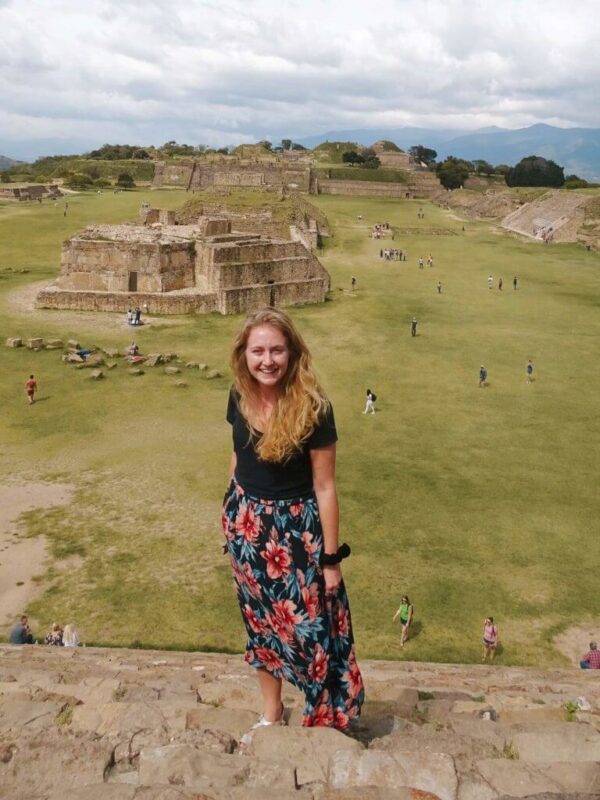
Half a day is all you need for Monte Alban, even if you visit by public transport. I don’t recommend skipping it because it’s one of the most important archaeological sites in Mexico – and even appears on the 20 peso note!
The UNESCO World Heritage Site of Monte Alban was founded by the Zapotecs in 500 BC and inhabited by over 17,000 people until it was abandoned in 1500 AD.
Spend 1-2 hours wandering around the vast ruins incorporating the Gran Plaza, the Los Danzantes carved monuments, and the ball court where the winners of the game were sacrificed to the gods! You can climb the two main temples for spectacular views across the valley to Oaxaca City. There’s also a small museum where you can learn more.
Entry fee: 90 pesos.
Getting to Monte Alban:
- Take a bus – this only costs 8 pesos from Central de Abastos to the nearest town. From here, you need to walk or board a motor taxi the rest of the way.
- Take a shuttle (80 pesos return) from the Lescas Co. Travel Agency office (in the Zocalo) or Autobuses Turísticos (Hotel Riviera del Angel). These run hourly between 8.30am and 5pm.
- Get a taxi for around 150 pesos each way (worth it for convenience if there’s a few of you).
- Take a tour – this is a convenient option including transport and a guided tour of the ruins.
Mitla archeological site
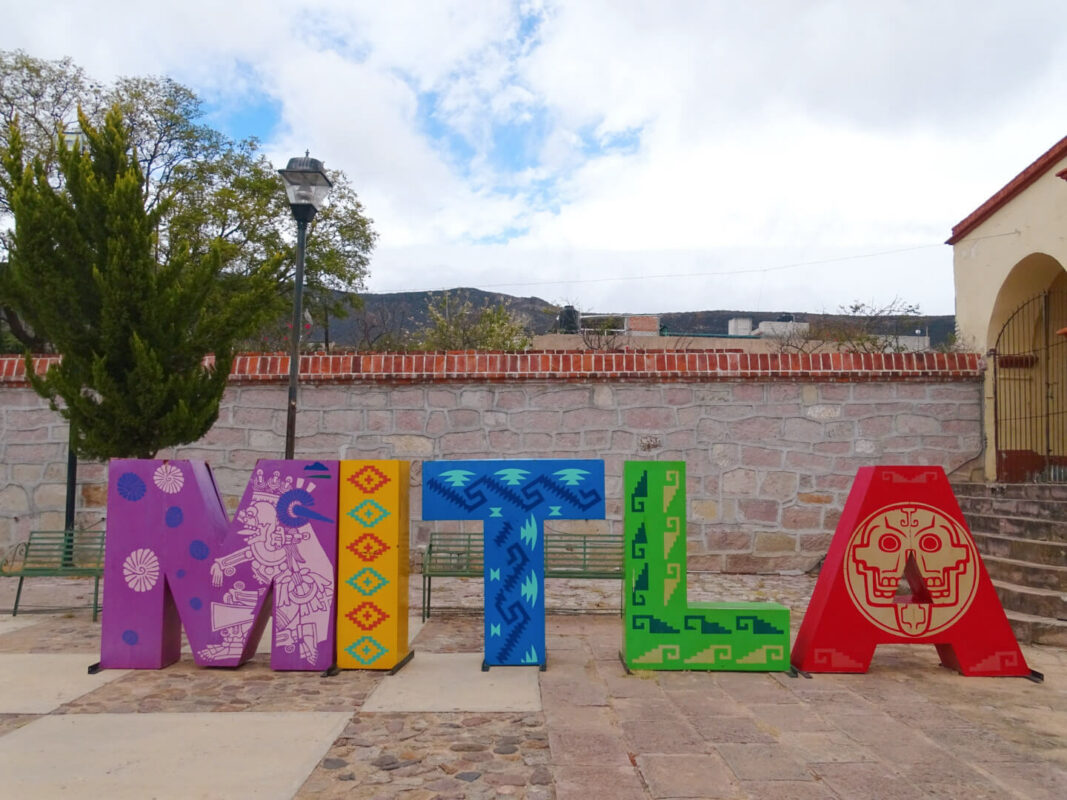
Mitla is the second most important archeological site near Oaxaca. Having visited both, I can say that Monte Alban is more impressive. That’s not to say don’t visit Mitla; just don’t dedicate an entire day to it.
The road leading to Mitla also connects other places like Hierve el Agua, the Tule Tree, Tlacoula Sunday Market, and several mezcal distilleries. I suggest you visit a few during the day, either by hiring a car, taking a guided day tour, or catching public transport (you need to transit via Mitla anyway to reach Hierve el Agua).
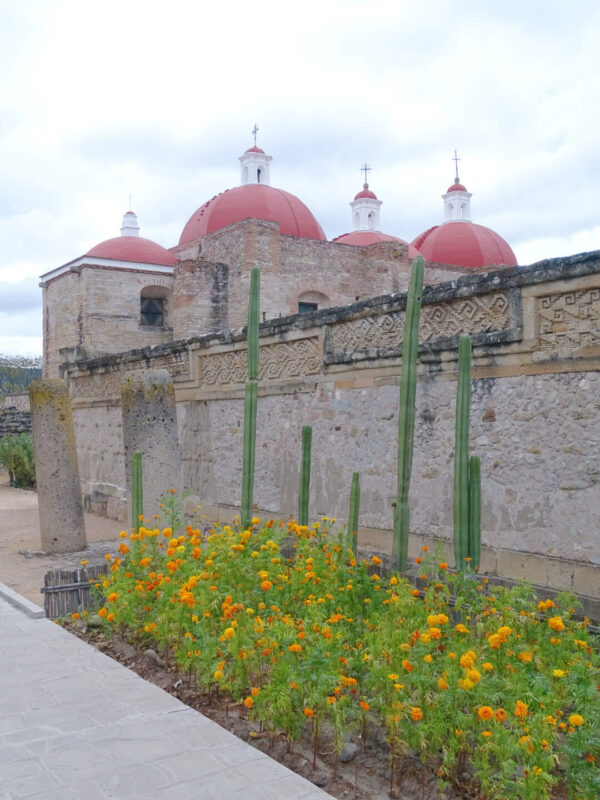
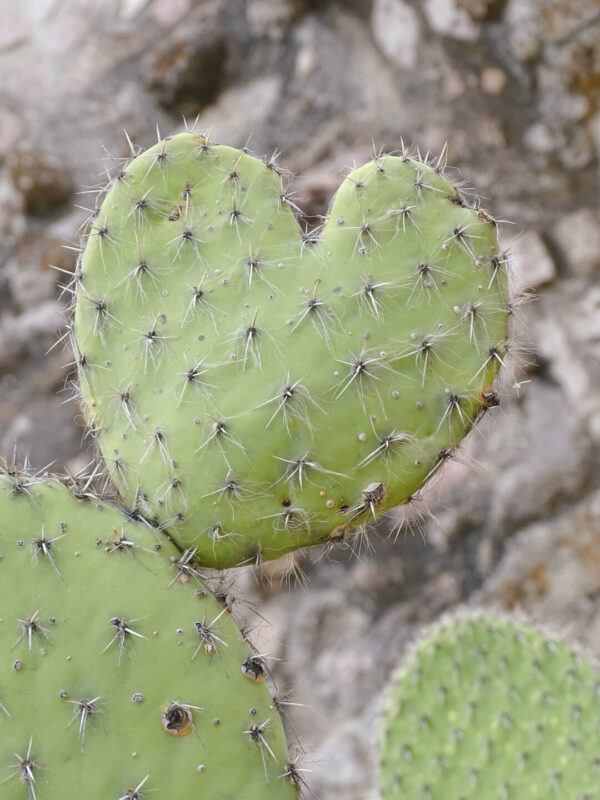
Mitla is both a town (San Pablo Villa de Mitla) and an archaeological site but it’s the latter that attracts visitors. Translating in Nahuatl as Place of the Dead, Mitla is a Zapotec site dating back to around 500 BC. It was a holy place due to the many human sacrifices carried out.
It only takes 30 minutes to wander the ruins and admire the greca carvings showing scenes from daily life.
Buses and shared taxis depart from this point near the Jalatlaco neighborhood. For the (red and white) taxis, hold up the same number of fingers as seats you require and pay approx. 30 pesos in cash to the driver when you get out.
Hierve el Agua
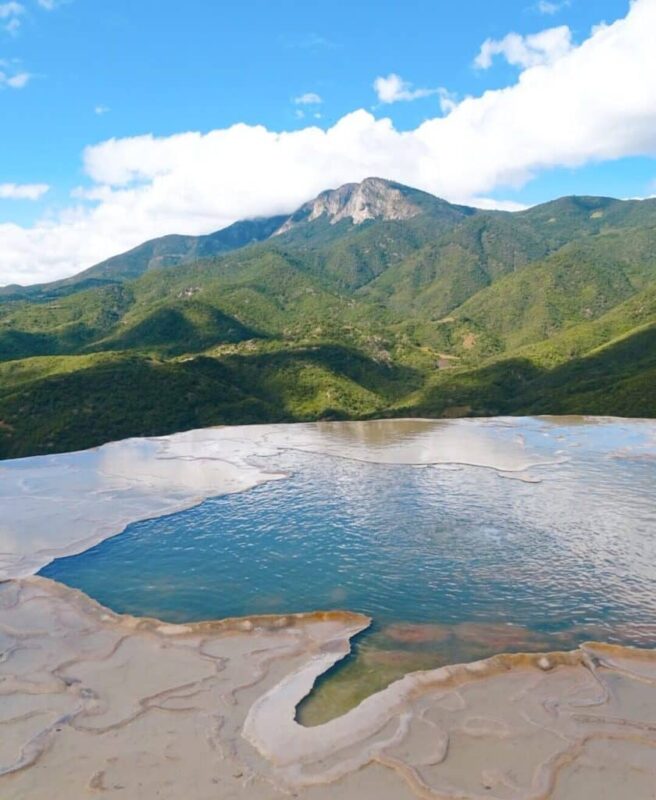
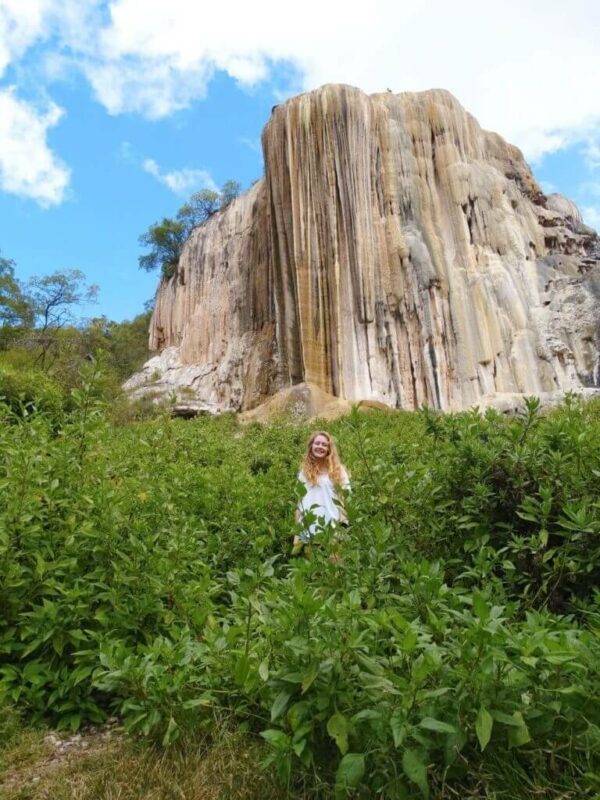
If you just have time for one day trip, I can happily vouch for Hierve el Agua as one of the best things to do near Oaxaca City. This magnificent natural wonder is often mistaken for a waterfall but it’s actually a stalactite, one of the few in the world found outside a cave.
Surrounding the feature are a series of natural pools, ideal for cooling down on a hot day. They do get very crowded, especially around Day of the Dead season, so I recommend going early if possible.
Ways to visit Hievre el Agua:
- By public transport: catch a bus or shared taxi from this point to Mitla then board a colectivo (shared truck) the rest of the way
- By car: the drive takes between 1.5 and 2 hours (take the road toward San Lorenzo to avoid the unpaved mountain road)
- By full day tour (including other attractions) – I recommend a tour with GetYourGuide as they start from $50 including transport. This tour includes Mitla, the Tule Tree, a weaving workshop, and mezcal distillery tour.
Tlacolula Sunday Market
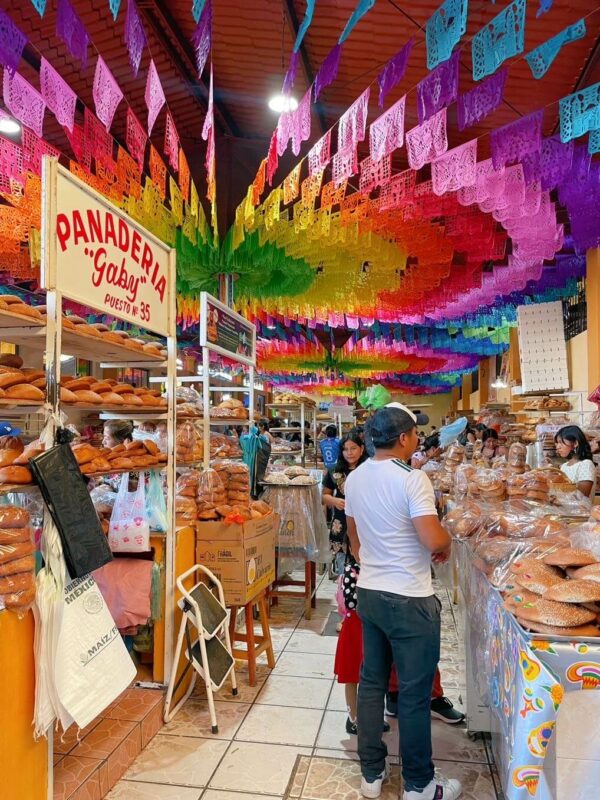
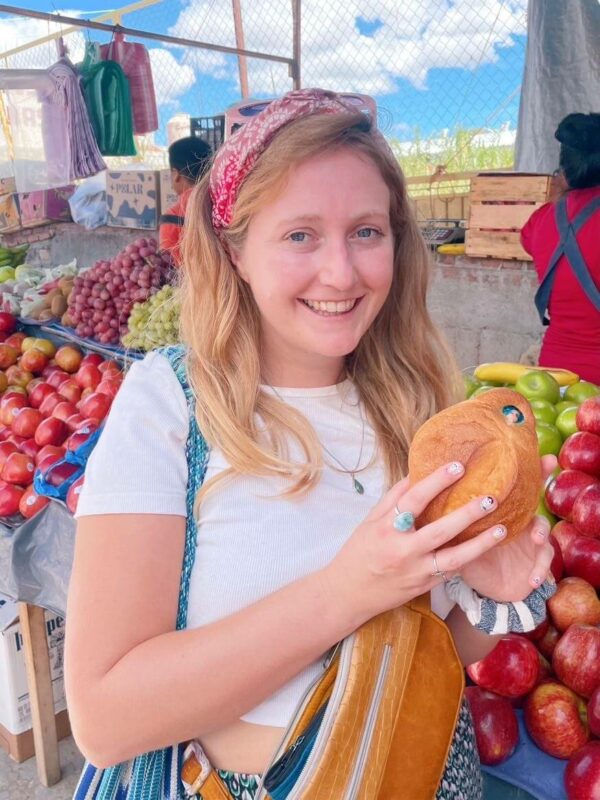
It wasn’t until my third trip to Oaxaca that I got around to visiting Tlacolula Market held on Sundays. Although it’s a 30-minute drive from the city in the small town of Tlacolula de Matamoros, it’s well worth the trip.
This vibrant market sprawls across the town on Sundays selling everything from colorful fruit, freshly baked bread, and quesillo cheese to beautiful handicrafts like silver jewelry, handpainted alejibres, and woven homeware items made by local female artisans. Even if you don’t buy anything, it’s a great half-day out.
To get there, catch a bus or red and white shared taxi from this point and get off on the highway in the town. To get back, wait for a vehicle on the other side of the road. I had no problem getting there and back by myself using public transport.
Read next: my guide to visiting Tlacolula Market
Teotitlán del Valle
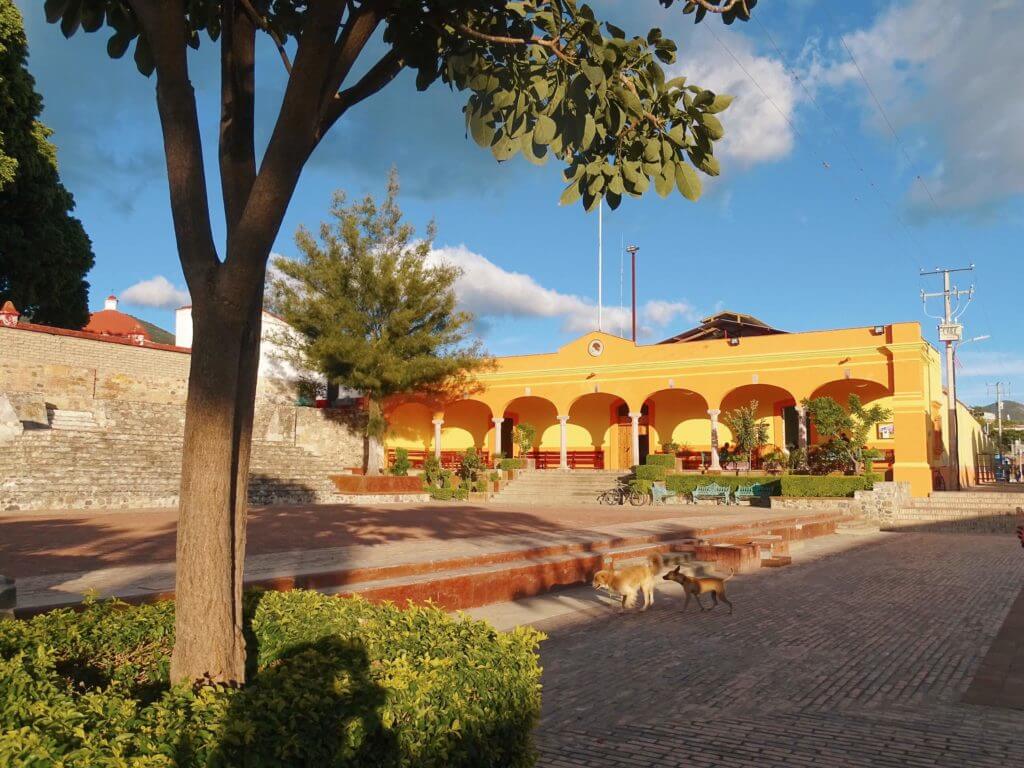
Another place near the attractions mentioned above is Teotitlan del Valle, a Zapotec town known for its weaving traditions dating back centuries. You can learn about how spectacular rugs are made using typical foot looms and natural colorings such as powder made from red cochineal bugs.
As well as visiting a workshop to see local artisans at work (and make a purchase if anything catches your eye), be sure to visit Centro Cultural Comunitario to learn about the history and see some incredibly detailed rugs that look like works of art!
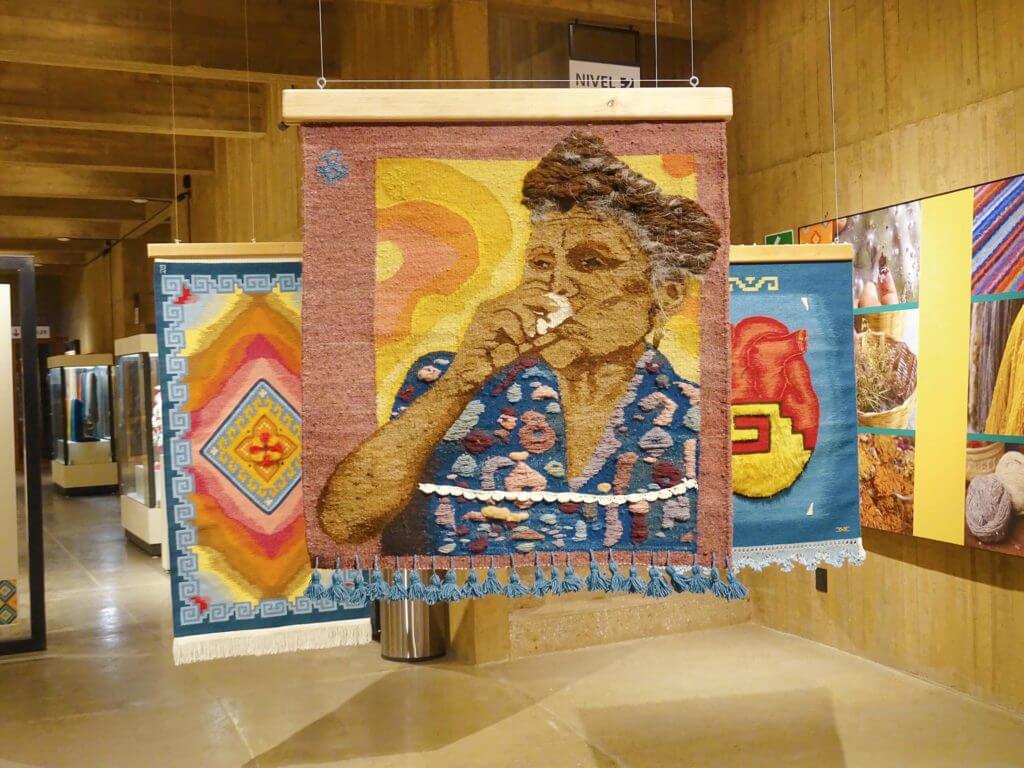
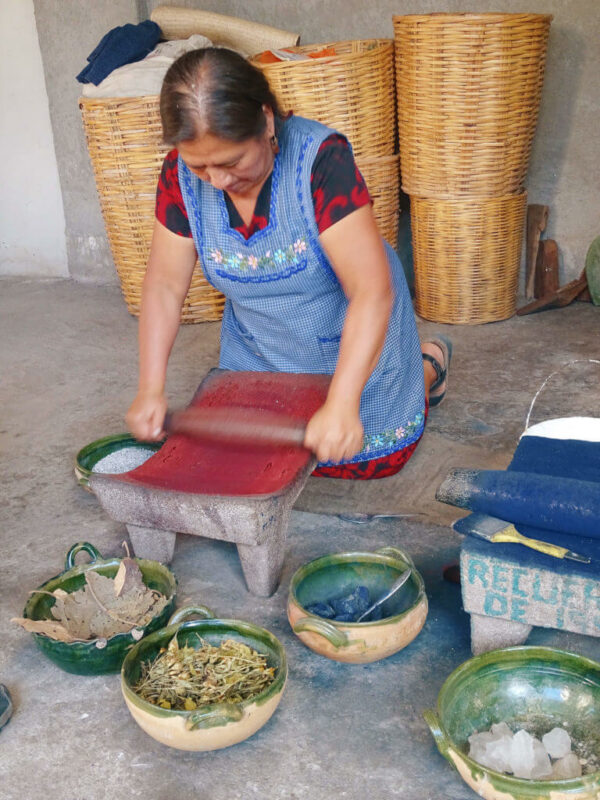
Note – Teotitlan is just a 15-minute drive from Tlacolula so you could consider visiting both on a Sunday market day. Without a car, you can find any bus or taxi from Oaxaca destined for Tlacolula and get out on the highway 4km from Teotitlan, then walk or hail another local taxi or tuk-tuk the rest of the way to the weaving town.
Visit the famous Tule Tree
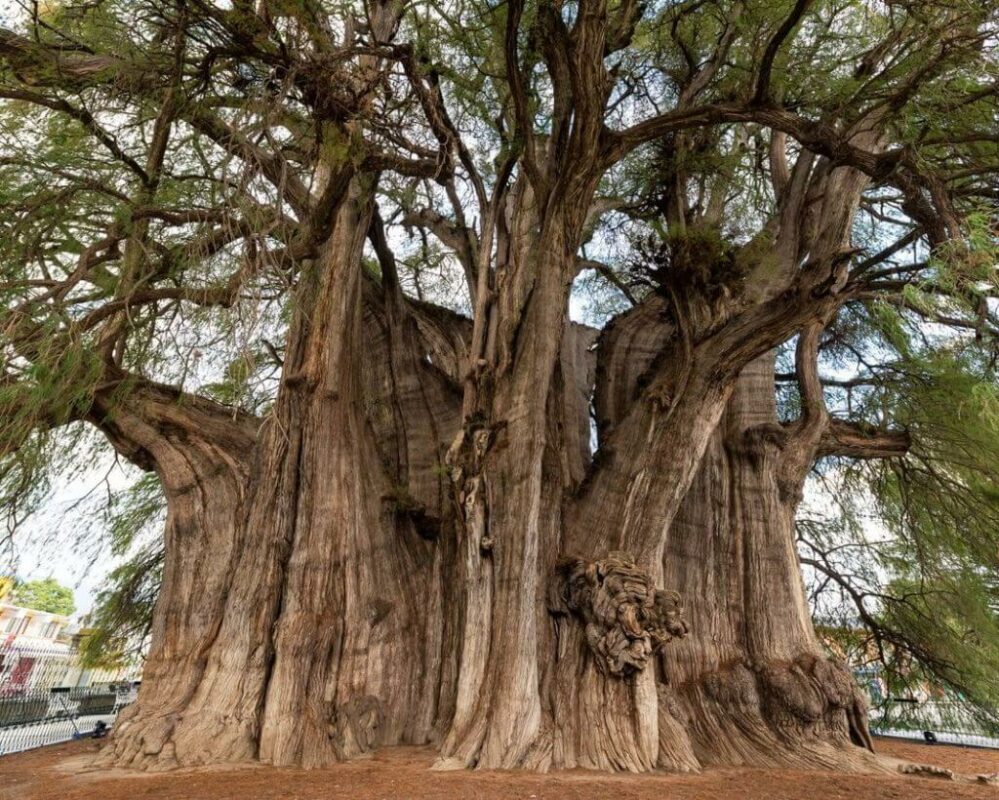
Visiting a tree may seem like a strange thing to do in Oaxaca but this isn’t any tree… It’s the world’s widest with a circumference of 42 meters (137 feet). El Árbol del Tule is a Montezuma Cypress located in Santa María del Tule that’s thought to be 2,000 years old making it the oldest tree in Mexico.
The tree was sacred to the Zapotecs and, in order to convert them to Christianity, the Spanish built a church beside it. If you go with a guide, they’ll point out the shapes of animals that are thought to reside in the branches.
The drive takes 20 minutes or you can even cycle there in under 40 minutes from the city. Regular passing buses bound for Mitla and Tlacolula can also drop you for under 10 pesos. Alternatively, it’s included in many tour group schedules visiting the other places mentioned above.
Hop between mezcal distilleries
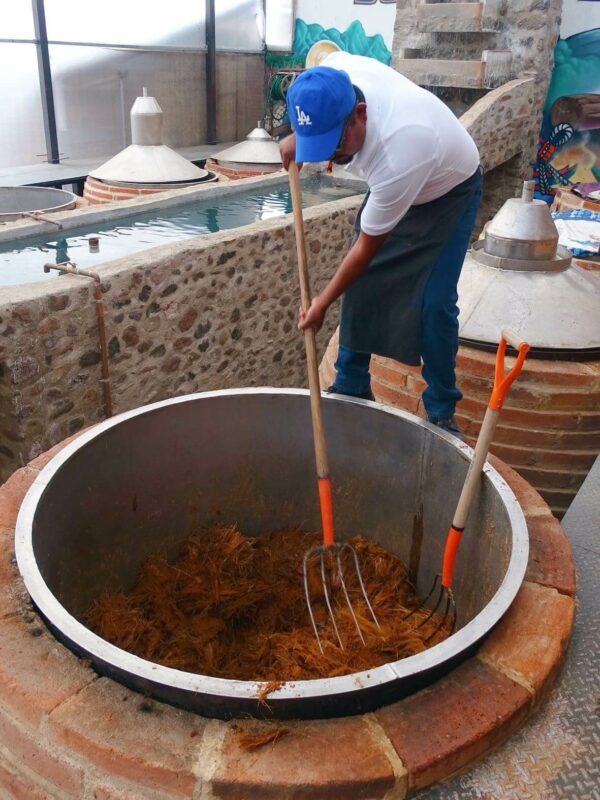
I already mentioned some of the mezcal bars in the city where you can sample this agave-based beverage. But for the real mezcal experience, your best bet is visiting a distillery, most of which are out-of-town along Highway 190 connecting many of the other Oaxaca attractions. It’s easy to visit independently or take a tour from the city.
Mezcal El Rey de Matatlán is a popular spot, located on the highway by the turn-off to Teotitlan del Valle. Like at the other distilleries, you’ll learn how mezcal is produced and get to see the different steps. After harvesting, huge agave plants are roasted underground before being crushed (often in the traditional style using horses) in a pit, and finally fermented and distilled.
A fun way to explore the plantations and learn from an experienced guide is a mezcal tour with Viator.
Hiking in the Pueblos Mancomunados
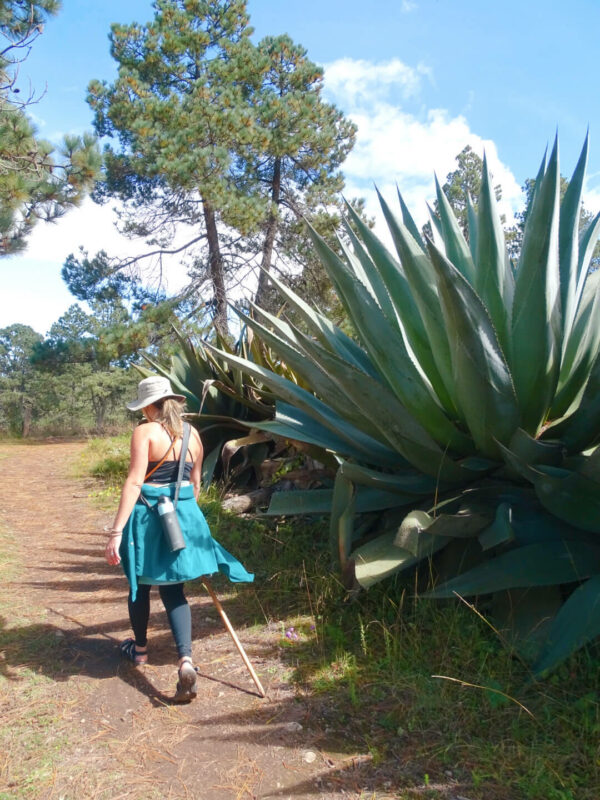
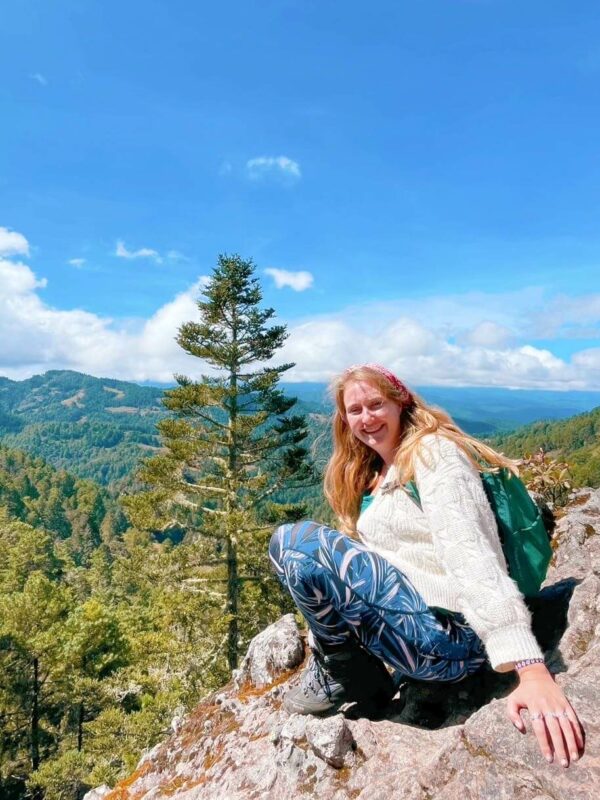
During my third and most recent trip to Oaxaca, I had the pleasure of hiking in the Pueblos Mancomunados, a series of indigenous villages semi-detached from Mexican society. These fascinating villages nestled in the Sierra Norte mountains of Oaxaca state have a strong community focus, farming their own food and using traditional medicine.
Thanks to the ecotourism project established by the villages, you can stay overnight in local accommodation and trek with a guide during the days. If you have just one day, I can recommend a return tour with Coyote Aventuras. I learnt so much from our guide about the culture and flora and fauna while hiking amongst the most beautiful scenery!
Mountain biking
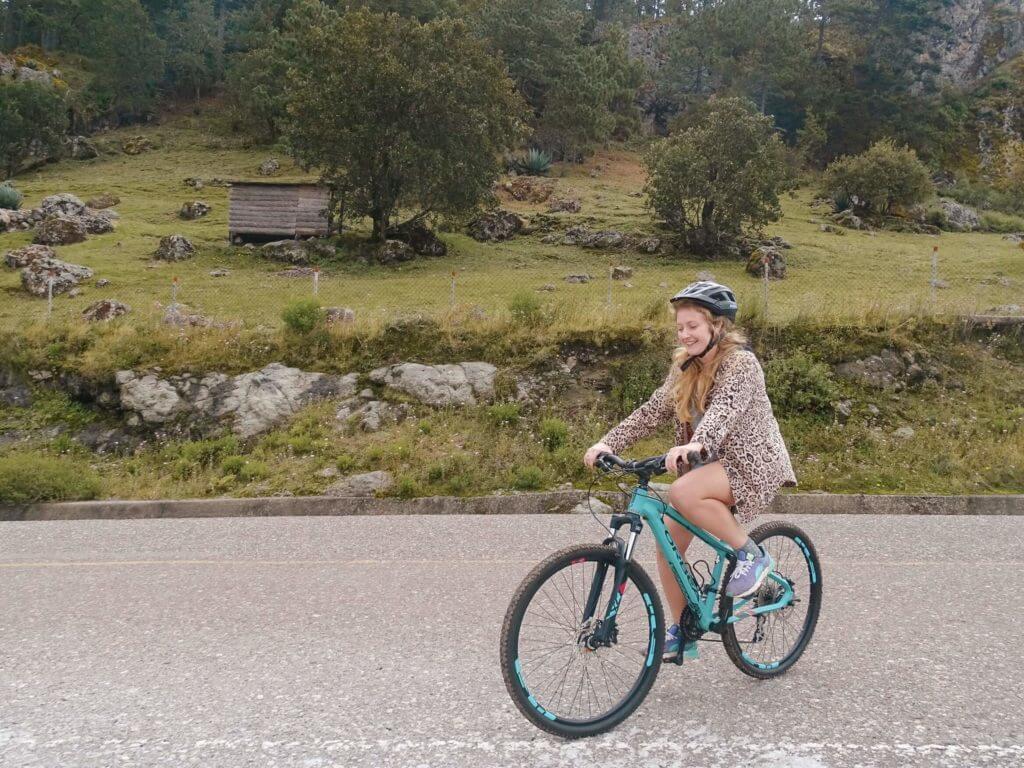
If the cultural and arty things to do in Oaxaca City aren’t for you, it’s easy to get into nature. One option is a mountain biking tour in the Sierra Norte mountains where the downhill trails (with a range for differing abilities) and switchbacks are world-class.
I did this myself as a tour in an effort to try new things. Well, it turns out mountain biking is NOT my thing (but at least I tried). However, the tour was well-led and the scenery incredible, so I have no doubt people better than me at mountain biking will enjoy it!
Santiago Apoala Waterfall
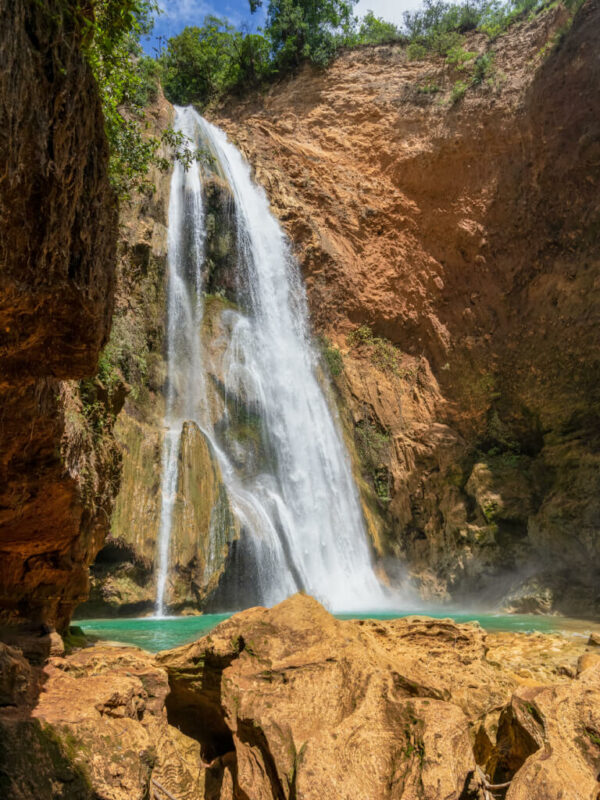
This hidden gem in the countryside is a wonderful excursion from Oaxaca for those in the know. Santiago Apoala Waterfall (Apoala meaning ‘breaking water’) is located just over 2 hours drive from the city so it’s a long day trip, but doable.
The appeal of visiting isn’t just the waterfall itself but the chance to experience rural Oaxaca, visit villages that feel like stepping back in time, and hike in the surrounding countryside.
You can visit by car to have complete control of your itinerary or as part of a guided tour group for an easy option that includes the knowledge and expertise of a local guide. No public transport connects the waterfall and city as of 2024.
Note – it’s necessary to visit the ecotourism office and pay 50 pesos to visit the falls. If you visit with a tour, they will organize this.
Annual things to do in Oaxaca
Let’s finish this blog post with a few final activities that you’ll need to time your trip around. The first is one of the best experiences in all of Mexico…
Day of the Dead (31 Oct-2 Nov)
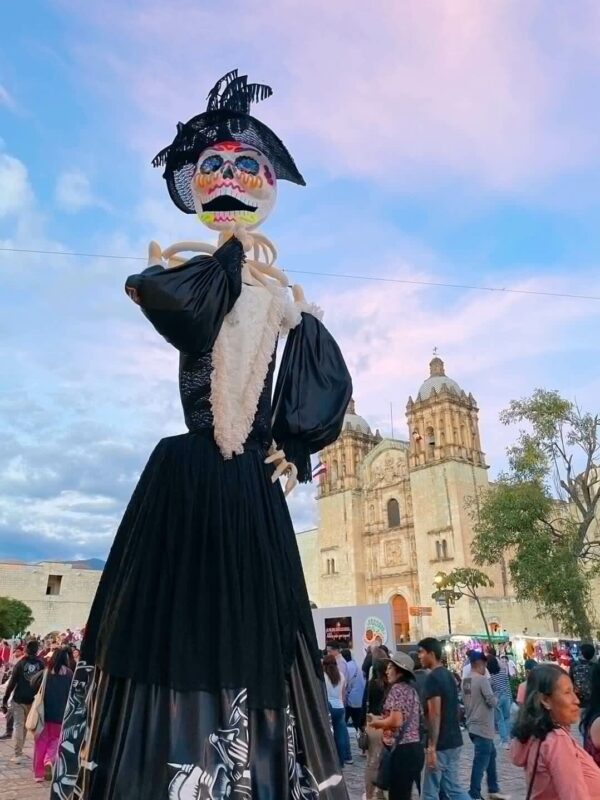
Dia de Muertos is a prehispanic celebration held for centuries in Mexico. Although it’s nothing to do with Halloween, it was moved by the Spanish from the original dates (the month of August to celebrate the end of harvest) to the current dates to match All Soul’s and All Saint’s Day, pagan celebrations that did indeed inspire All Hallow’s Eve.
Nowadays, it’s a blend of prehispanic Mexican traditions blended with European pagan elements. It’s a wonderful cultural event and Oaxaca is one of the most popular places to experience it… To the point that all the accommodation books up months in advance, so be organized if you want to visit!
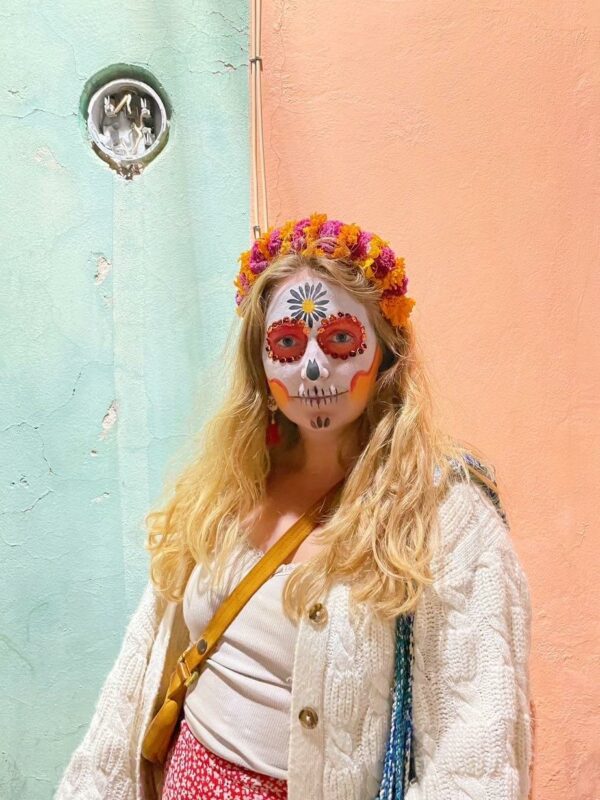
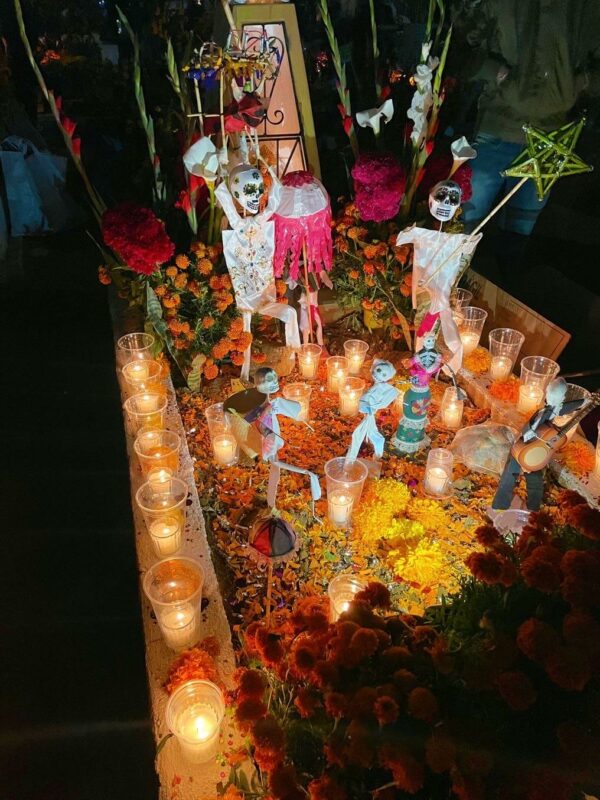
The town is decorated with huge La Catrina statues, orange cempasuchil flowers, ofrendas (altars dedicated to deceased family members), and sand tapestries, while huge parades take to the streets throughout the week.
During the key nights of 31 October and 1 November, locals visit cemeteries where it’s believed that spirits of loved ones passed return to. Head to Xoxocotlan (lively vibe) or Atzompa (a quieter, local place) on 31 October. See my guide to Day of the Dead Oaxaca.
Guelaguetza (July)

This summer festival is another fantastic one to experience if your trip lines up. Guelaguetza celebrates the many different communities in Oaxaca with their various languages and traditions comprising dance, dress, and festivities.
The other name for the festival is Lunes del Cerro (Mondays on the Hill) and gives a clue as to when the festival was originally held: the last two Mondays of July. However, now celebrations happen all month. The festival’s main events are held on Fontin Hill where there’s now an auditorium (Guelaguetza Auditorium) that seats 11,000.
Every year a woman from the community is chosen to represent Centeotl (the corn goddess) based on her extensive knowledge of the festival. Another part of the festival is the parades led by ‘Chinas’ (women in traditional dress), featuring giant lanterns and puppets.
Unlike Dia de Muertos, it’s not free to attend. You can buy tickets on Ticketmaster but they sell out in advance, so be organised!
Night of the Radishes (23 Dec)
If you happen to be in town over Christmas, you can experience the Night of Radishes (Noche de Rábanos), a quirky festival dating back over 100 years. Around the festival’s origins in 1897, vendors would try to make vegetables look more interesting by turning them into sculptures. The trend caught on and nowadays, it’s an elaborate competition with artists making the craziest sculptures possible!
Many designs have a Christmas theme showing nativity scenes and Catholic saints, while others depict musicians, buildings, and more.
In the morning, you can see artists working on their designs that, by the evening, are spread across the main square in all their glory. Fireworks and celebrations follow.
FAQs
How many days do you need in Oaxaca? I would say 1-2 days are necessary to see Oaxaca City then a further two for the surrounding attractions. If you have just three days, use one to visit Monte Alban and another for Hierve el Agua, Teotitlan de Valle, the Tule Tree etc.
How do you pronounce Oaxaca? Wa-hak-ah! It’s confusing the first time you see the word but easy when you get the hang of it.
How do you spend a day in Oaxaca? Start with brunch at Boulenc or Muss Cafe then visit the Botanic Gardens and Cultures Museum. Explore the Zocalo and art galleries, stopping for street food at Tacos del Carmen or 20 de Noviembre Market. Wander colorful Jalatlaco neighborhood in the afternoon.
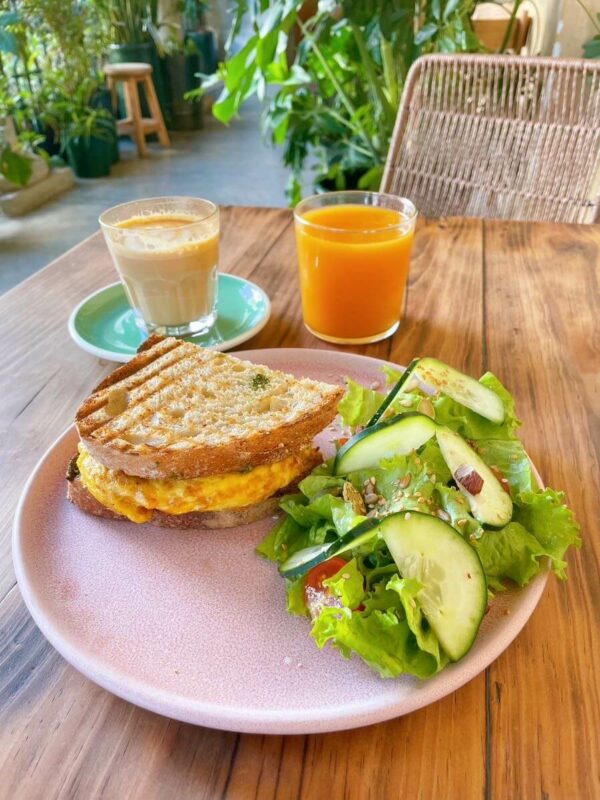
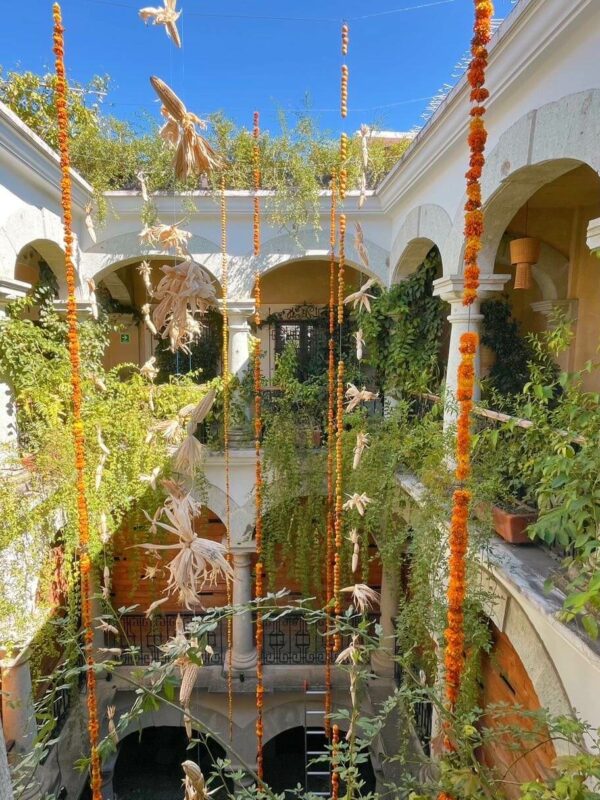
Is it worth going to Oaxaca? Absolutely! This is one of my favorite places in Mexico (and the competition is stiff!). There are so many things to do in Oaxaca City from art to culture and cuisine… There’s no way you’ll get bored!
Is Oaxaca a walkable city? Yes, it’s easy to get everywhere on foot; the city is perfect for pedestrians because parts of the Zocalo like Calle Macedonio Alcalá are car-free. Even in the suburbs, there are sidewalks, although tree roots push through parts of them so watch your step!
Can you drink the water in Oaxaca? No! Buy bottled water or, to be more sustainable, bring a metal water bottle: most accommodations will let you fill up from large, filtered units. Alternatively, bring a filtering water bottle that makes any water safe to drink.
Is Oaxaca safe? Yes, it is a safe city for tourists. But, like anywhere, watch your valuables in crowded places and avoid walking late at night, especially alone.
What’s the best time to visit Oaxaca?
The dry season (October-April) is the best time to visit because the pesky rainfall is done, and it’s not yet too hot. April and May are the hottest months reaching 84°F (28°C).
If you want to experience Day of the Dead or Guelaguetza, visit from 31 Oct-2 Nov or the month of July, but be prepared for crowds and high prices! Obviously, avoid the city in these periods if you’re not there for the festivals.
If you don’t mind the heat and rain, visiting from May to October is a good idea for lower prices and reduced crowds.
Final thoughts on what to do in Oaxaca
As you can tell, there’s a lot going on! Having visited now three times for at least a week each, I’d say that my favorite activities in Oaxaca City are wandering the markets, the Botanical Gardens, and the Museum of Cultures.
My favorite places nearby are Hierve el Agua and Monte Alban. So if you just had three days, I’d spend one day in the city and a further two visiting those places (Hierve el Agua can be combined with other places on the way home like Mitla and Teotitlan del Valle), while Monte Alban just takes half a day.
Thanks for reading!
Read more Oaxaca City posts:
- Guide to visiting Jalatlaco neighborhood
- How to visit Tlacolula Market
- Hiking in the Pueblo Mancomunados villages
Read more Oaxaca state posts:

